ISLE OF MAN HOLIDAYS REMEMBERED
Before the advent of cheap flights to the 'Costa del Anywhere' the Isle of Man was about as far abroad as hundreds of thousands of holidaymakers from Lancashire, Yorkshire and Clydeside ventured. They sailed to Douglas from Liverpool, Fleetwood and Ardrossan on the regular sailings of the Isle of Man Steam Packet Company Ltd (IOMSP) which operated a fleet of fast, attractive 'mini-liners' whose house colours on the funnels were the same as Cunard. Other ports served during the main holiday seasons included Dublin, Belfast, Heysham and Llandudno. Sailings to and from Ardrossan also called at Ramsey Pier in the north of the Island; indeed everyone went by sea, certainly we regularly took day trips during the 1960s and early 1970s; this is a view (below) of the foredeck of the IOMSP's 'Snaefell' approaching Douglas.


(Above) Another view of the harbour approach: four boats are tied up alongside the Victoria Pier; nearest the camera is the 'Lady of Man' and on the opposite side of the pier is the 'Ben-my-Chree'. These were the largest two boats in the fleet and therefore both were berthed at the seaward end of the Victoria Pier. The other two boats tied up at the Victoria Pier are not identifiable.To the left is the King Edward Pier with a fifth unidentified boat alongside and the harbourmaster's office visible at the end. Out of sight to the left is the Battery Pier giving protection to the harbour from the open sea. Fishing and freight boats used the Inner Harbour by sailing along the channel to the left of the King Edward Pier. The terrace of tall hotels and boarding houses on the extreme right of the photograph is the start of the Loch Promenade. Please note this is a super-wide image and you will need to 'click-on' twice (not double-click) to see the full-size image.
largest two boats in the fleet and therefore both were berthed at the seaward end of the Victoria Pier. The other two boats tied up at the Victoria Pier are not identifiable.To the left is the King Edward Pier with a fifth unidentified boat alongside and the harbourmaster's office visible at the end. Out of sight to the left is the Battery Pier giving protection to the harbour from the open sea. Fishing and freight boats used the Inner Harbour by sailing along the channel to the left of the King Edward Pier. The terrace of tall hotels and boarding houses on the extreme right of the photograph is the start of the Loch Promenade. Please note this is a super-wide image and you will need to 'click-on' twice (not double-click) to see the full-size image.
(Below) A fine view of Douglas Harbour's Victoria Terminal and distinctive clock tower circa 1930s courtesy Barry Hilton's family album; the busy scene shows IOMSP boats tied up alongside the pier, several horse-drawn tram vehicles and the glass roofed arcade on the right. Since the arrival of today's vehicle roll-on roll-off ferries the mass foot-passenger traffic seen in this picture is now very much a thing of the past.


(Above-Below) Douglas Harbour is well sheltered from the westerlies but when gales blow up from the east the harbour is exposed. the IOMSP boats occasionally had to head to the west of the Island - Peel or Port Erin when strong winds came from the east. This map section of the Isle of Man circa-1946 shows some of the shipping routes from mainland Britain; the map has been scanned, cleaned and digitised from an old, out of copyright original by The New Society for the Diffusion of Knowledge (NSDK)...the full map can be found on the Society's excellent website HERE. (Below) After disembarking at the King Edward Pier we see the bow of 'Snaefell' on the right and three other IOMSP boats at the Victoria pier; the tall funnel belongs to the famous 'Lady of Mann' of 1930, the flagship of the fleet.

 The Isle of Man measures 35 miles by 15 miles, its magnificent scenery varying from flat plains to deep river valleys (Glens) and rolling hills, the highest of which, Snaefell - the snow mountain - rises to just over 2,000 feet high. The influx of holidaymakers concentrated on the capital, Douglas on the eastern seaboard. The main entertainment venue in the resort was the Villa Marina and most years the star attraction was Joe Loss and his Band.
The Isle of Man measures 35 miles by 15 miles, its magnificent scenery varying from flat plains to deep river valleys (Glens) and rolling hills, the highest of which, Snaefell - the snow mountain - rises to just over 2,000 feet high. The influx of holidaymakers concentrated on the capital, Douglas on the eastern seaboard. The main entertainment venue in the resort was the Villa Marina and most years the star attraction was Joe Loss and his Band.
Who, if anyone, now remembers Cunningham's Camp for Young Men at Onchan?
Perhaps a few more can recollect the requisitioned Hotels along the seafront at Douglas used for the internment of enemy aliens between 1939 and 1945. And what about having to don lifejackets on departing from Liverpool as U-Boats had been busy laying mines in the Mersey estuary?
Bacon, butter and other dairy produce was not rationed in the Isle of Man, at least in the first years of the war, so returning holidaymakers stocked their cases full of rationed foodstuffs, only in many instances they were confiscated by HM Customs on arriving at Liverpool. After the blitz in December 1940, Liverpool Docks were devastated and conditions in the Mersey became so dangerous that the regular Isle of Man sailings were transferred to Fleetwood from the start of 1941 until 1946. The Isle of Man steamer 'Victoria' did hit a mine in the Mersey estuary but fortunately was not seriously damaged. Victoria had been acquired second hand, having originally been built for the South Eastern and Chatham Railway for cross-Channel work.
 The Island was and still is especially famous among the motorcycling fraternity for the world famous TT road races, and the lesser important GP week.I wonder if the 'Manx Norton' motorcycle is still displayed in the Crosby Hotel?
The Island was and still is especially famous among the motorcycling fraternity for the world famous TT road races, and the lesser important GP week.I wonder if the 'Manx Norton' motorcycle is still displayed in the Crosby Hotel?
When on family holidays in Douglas during TT week, we might stay in the same establishment as some of the TT riders; this was a chance to politely request one of the race numberplates carried on the bikes; the Senior Race riders had a red background and the Junior Race riders blue. The race had a staggered start, with the faster riders in the practice runs going off first to avoid the slower bikes; one year my sister and I bagged a couple of souvenirs: a red numberplate number 16 and a blue junior numberplate about 59. And of course, on returning home we rode around on our pedal bikes for some time with the handlebars adorned by them.
A somewhat tongue-in-cheek impression of the TT races can be obtained from the 1935 George Formby comedy film, 'No Limit' (left).
Night Owls listening to the BBC's midnight Shipping Weather Reports will be familiar with the term 'Ronaldsway' and how visibility there was usually the best in all the UK reports; the weather reports had earlier come from the RAF base at Jurby in the north of the Island until it closed.
Everywhere you could buy Manx kippers and even have them mailed to the folks back home. There is a native breed of sheep and, of course, the famous Manx cats with no tails. Nowadays financial services are the biggest earner, taxes are low and the Island is governed by the 'House of Keys' which claims to be the oldest uninterrupted parliament in Europe. The Isle of Man is not part of the United Kingdom; nor does it come under the rule of the EU, luckily for them! The island's official status is that of a self governing Crown Dependency therefore its old fashioned practices have not all been banished in the mistaken pursuit of progress.
 Listeners to BBC's 'News from the North' frequently heard how day trippers bound for Douglas on the coal burning 'Viking' spent the day on a sandbank off Fleetwood. 'Viking' spent 49 years in service with the IOMSP fleet and on war service; indeed the IOMSP's ships played a big part in the Dunkirk evacuation.
Listeners to BBC's 'News from the North' frequently heard how day trippers bound for Douglas on the coal burning 'Viking' spent the day on a sandbank off Fleetwood. 'Viking' spent 49 years in service with the IOMSP fleet and on war service; indeed the IOMSP's ships played a big part in the Dunkirk evacuation.
Into the nineteenth century the Island belonged to the Lord Derby and the name 'Derby' is perpetuated in Derby Castle at Douglas, also by one of the long-withdrawn 2-4-0T steam locomotives No2 'Derby' and the famous horse race latterly run at Epsom which started as a race at Derbyhaven near Castletown in the south of the island.
There are so many attractions for the historically minded, from ancient crosses and burial grounds to the famous 'Lady Isabella' waterwheel (right) once used to pump water out of the old lead mines. Much of the public transport system has a Victorian flavour; the steam railway, the Manx Electric Railway and the mountain line to the summit of Snaefell are all operated by the island's Department of Tourism & Leisure. Horse trams still ply the front at Douglas in summer - indicated 'E' on the map below, while the Manx Electric Railway 'D' runs from Derby Castle at Douglas to Ramsey, connecting with the electrified Snaefell Mountain Railway at Laxey. The cable car system to Upper Douglas is not even a memory now but a part of the Isle of Man Railway still continues in operation.
In 1873 the first railway opened between Douglas and Peel (indicated 'B' on the map below); next a more ambitious line was built from Douglas to Port Erin 'F'. An independent concern, the Manx Northern Railway, built a line from St John's on the Peel line round the west coast to Ramsey 'A', along with another line to the lead mines at Foxdale. The MNR was soon taken over by the IMR.


(Above-Below) The first section of the 3ft-gauge Manx Electric Railway was opened between Douglas and Groudle in September 1893. The line was extended to Laxey in July the following year, and then on to Ramsey (Ballure) four years later. The final leg of the 500vDC route was completed to Ramsey (Plaza) in July 1899. (Above) Back in the day when cars had vinyl roofs, tramcar No 26 and trailer was photographed at Derby Castle station at the northern end of Douglas promenade. This vehicle was one of four open cars Nos 24-27 purchased from GF Milnes & Co in 1898, and subsequently dubbed 'paddleboxes' due to their unusual footboards being built to accommodate the protruding bogies. Opened in 1893 the MER's Derby Castle terminus was so called because the area at that time housed a vast entertainment complex of that name. In the background can be seen the now-demolished Aquadrome Swimming Pool & Sauna which was part of the Summerland indoor leisure complex; the three-and-a-half acre building was clad in part with a new Perspex-like material, which proved to be disastrous when the complex was engulfed in flames on the evening of 2nd August 1973. Within minutes the whole site was ablaze and fifty people lost their lives. (Below) Manx Electric Railway Car No 6 is reversing at Groudle Glen. This vehicle was among the second batch of six cars Nos 4-9 delivered to the railway for its opening to Laxey in 1894. They were referred to as 'tunnel cars' because their seating was originally fitted parallel to the sides with just one large passenger saloon as opposed to the more traditional reversible seating common in tramcar layout.
Derby Castle station at the northern end of Douglas promenade. This vehicle was one of four open cars Nos 24-27 purchased from GF Milnes & Co in 1898, and subsequently dubbed 'paddleboxes' due to their unusual footboards being built to accommodate the protruding bogies. Opened in 1893 the MER's Derby Castle terminus was so called because the area at that time housed a vast entertainment complex of that name. In the background can be seen the now-demolished Aquadrome Swimming Pool & Sauna which was part of the Summerland indoor leisure complex; the three-and-a-half acre building was clad in part with a new Perspex-like material, which proved to be disastrous when the complex was engulfed in flames on the evening of 2nd August 1973. Within minutes the whole site was ablaze and fifty people lost their lives. (Below) Manx Electric Railway Car No 6 is reversing at Groudle Glen. This vehicle was among the second batch of six cars Nos 4-9 delivered to the railway for its opening to Laxey in 1894. They were referred to as 'tunnel cars' because their seating was originally fitted parallel to the sides with just one large passenger saloon as opposed to the more traditional reversible seating common in tramcar layout.


(Above) Opened on August 21 1895, the 3½ft gauge Snaefell Mountain Tramway was equipped with a Fell centre rail (for braking purposes) and operated between Laxey and Snaefell Summit. The line was incorporated into the Isle of Man Tramways & Electric Power Co Ltd before the Manx Electric Railway Co Ltd took over the running of the line in August 1902; a little over fifty years later the company's operation was acquired by the Manx Government in 1956. Today the line comes under the auspices of the island's Department of Tourism & Leisure.
(Below) the TT course crosses the line of the Snaefell Mountain Railway at 'Bungalow' (see map below) and during the races the SMR runs shuttles to both sides of the road with a scaffolding footbridge across the road itself for its passengers


(Above) Rail Cameraman, Barry Hilton's family interest in the Isle of Man began in the early 1900s. His grandfather worked for the Bradbury's Motorcycle Company in Oldham, Lancashire prior to its closure in 1924. Being a keen motorcycle enthusiast he regularly went to the TT Races, and at the outbreak of WW1 (he was too young to enlist) he became a dispatch rider, until he fell off his motorcycle and broke his arm! Barry's father recalls taking regular trips to the IOM as a boy in the 1930s; this is a cheeky shot of him posing precariously on the front of an ex-Manx Motors Daimler single decker, Fleet No 81 - ADC 416A chassis, Bell body - registration No MN5511 at Laxey. The vehicle was withdrawn in 1949.
(Below) Fast-forward 70-odd years to April 2011, and Barry decided to take a nostalgic trip back to the island to celebrate his dad's 87th birthday. After catching the ferry from Heysham, they spent a week touring by bus, tram and train, revisiting the old tourist sites at Port Erin, Ramsey, Peel, Laxey and a tram ride to the top of Snaefell. These colour shots are a record of their trip on the Snaefell Mountain Railway. His dad thoroughly enjoyed his IOM trip although he said the greatest thing he missed were the old Steam Packet Boats!

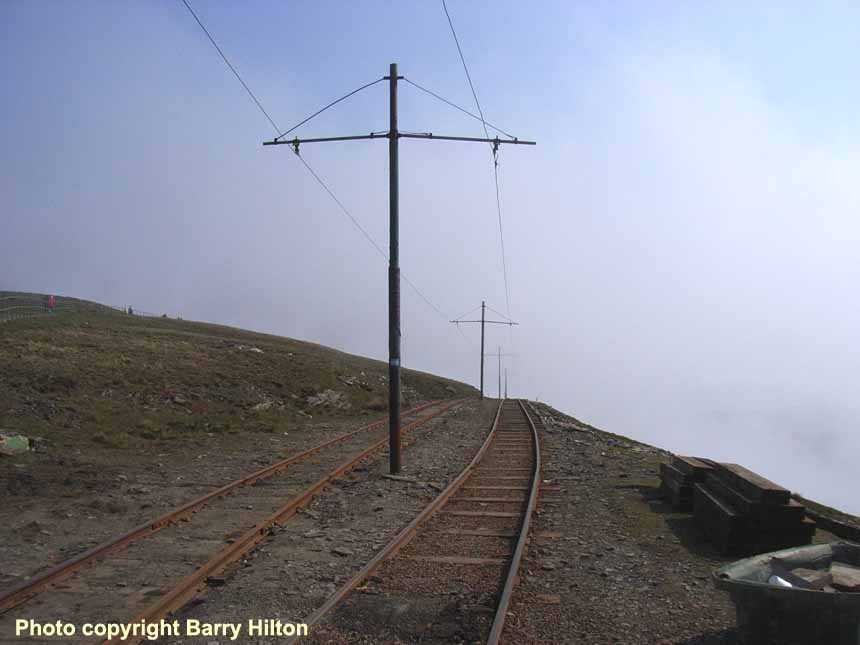

ISLE OF MAN STEAM
 Eighteen steam locomotives have worked the three foot gauge system, fifteen of them being 2-4-0Ts built by Beyer Peacock of Manchester, fourteen built for the IMR and one for the MNR. These IMR locomotives came in various sizes. The MNR originally had two small 2-4-0Ts built by Sharp Stewart also of Manchester. These proved too small so the Manx Northern Railway acquired its own 'Peacock'. After the merger this became IMR No 14 'Thornhill'. The odd man out was a 0-6-0T No 15 'Caledonia', built by Dubs of Glasgow for handling the ore traffic on the steeply graded Foxdale line.
Eighteen steam locomotives have worked the three foot gauge system, fifteen of them being 2-4-0Ts built by Beyer Peacock of Manchester, fourteen built for the IMR and one for the MNR. These IMR locomotives came in various sizes. The MNR originally had two small 2-4-0Ts built by Sharp Stewart also of Manchester. These proved too small so the Manx Northern Railway acquired its own 'Peacock'. After the merger this became IMR No 14 'Thornhill'. The odd man out was a 0-6-0T No 15 'Caledonia', built by Dubs of Glasgow for handling the ore traffic on the steeply graded Foxdale line.
This selection of photographs contains pictures from 1959, 1960 and 1964. We did not have a car back then and had to rely on public transport. Douglas station was the headquarters of the Railway. This is the view (left) from a train approaching Douglas station from the Port Erin line.
(Below) Freight traffic was often carried in wagons attached to passenger trains. This shot shows ex-MNR No 14 'Thornhill', detaching the two open wagons from a train which had just arrived from Port Erin. No 14 is a former Manx Northern Railway locomotive.


(Above-Below) No 1 'Sutherland' built 1873 is acting as station pilot, shunting wagons. No 1 retains the small boiler, Salter Safety valves on top of the dome and small sidetanks of the original engines. Note also the old-fashioned sloping front to the smokebox (Below) The other view of goods being shunted at Douglas shows No 5 'Mona' which has been rebuilt with a larger, higher pressure boiler and larger sidetanks. It was as a somehwat bored small boy in 1948 one wet Sunday afternoon in Ramsey I found that it was possible to move one of the MER box vans merely by pushing it!
At this juncture I'd like to thank John Kinley for dropping a line. The need for accurate details in captions is important; this is especially the case when captioning old photos from fifty-odd years ago… it seems such a long time ago!
John kindly writes...
'I just wanted to say how much I enjoyed the IMR pictures; absolutely brilliant! Thanks so much for sharing. Apologies for being a pedant but I think you may have got a couple of the locos wrong in the pictures…the IMR locos do all look very similar at first glance but they all have their own little quirks, such as domes/ safety valves/ chimneys and patches on the tanks, which, once you know them, enables you to tell the difference, even if you can't see the number!
For example, the picture (above) of No 1 'Sutherland' shunting is almost certainly No 14 'Thornhill'. Number One had lost her Salter valves by the early 1960s and has a pop valve in the dome and one on the first ring of the boiler barrel known as one of the two 'Bradshaw' boilers (it also still had its chimney numeral). The second picture (below) of No 5 'Mona' shunting is almost certainly No 6 'Peveril'. No 5 had lost her copper capped chimney in about 1946 when it was re-boilered and the lack of cab side builder's plate means it isn't No 13 'Kissack'. Finally, the 'tail' loco (third photo below*) is No 10 'GH Wood' (note the cast chimney/closed dome/ curved patch on the front of the tanks - another photo of No 10 at St John's appears further down the page). Number 3 'Pender' still has a small boiler at her current home in the Science Museum in Manchester (the second Bradshaw boiler as described above).
Hope this info helps and thanks again for sharing them
Best Wishes, John Kinley (Isle of Man).
PS Love the Northern Ireland pics as well!


(Above-Below) Trains from Peel and Ramsey were often combined at St John's and run 'top and tail' in modern parlance. Arriving at the head of a combined train at Douglas is No 12 Hutchinson. (Below*) Following arrival and smart work uncoupling, the 'tail' loco No 3 'Pender' sets off for the shed. Originally 'Pender' was a small boiler engine but it was later rebuilt with a larger boiler...the loco in this picture has now been identified as No 10 'GH Wood'.


(Above-Below) The third shot of a sequence of four - all taken within minutes of one another - shows No 12 heading off along the centre release road. Note the Royal Mail van visible on the platform. (Below) The final shot from the platform shows No 12 on one of the shed roads; baskets were used for hand coaling.


(Above-Below) No 3 'Pender' gets into the act again running along the release road after arrival. (Below) No 12 'Hutchinson' and 8 'Fenella' are seen waiting on the headshunt which leads to the shed. No 8 has one of the small boilers and small side tanks of the first locomotives, however after acquiring a new boiler the increased boiler pressure made it a much better performer.


(Above-Below) The same two locos are seen after coming off the shed headshunt. (Below) St John's was the junction where the Peel and Ramsey lines split. Each route through the station had a loop so there were four platform faces. A general view of the station from the west end shows the Ramsey train on the left and the Peel train on the right.
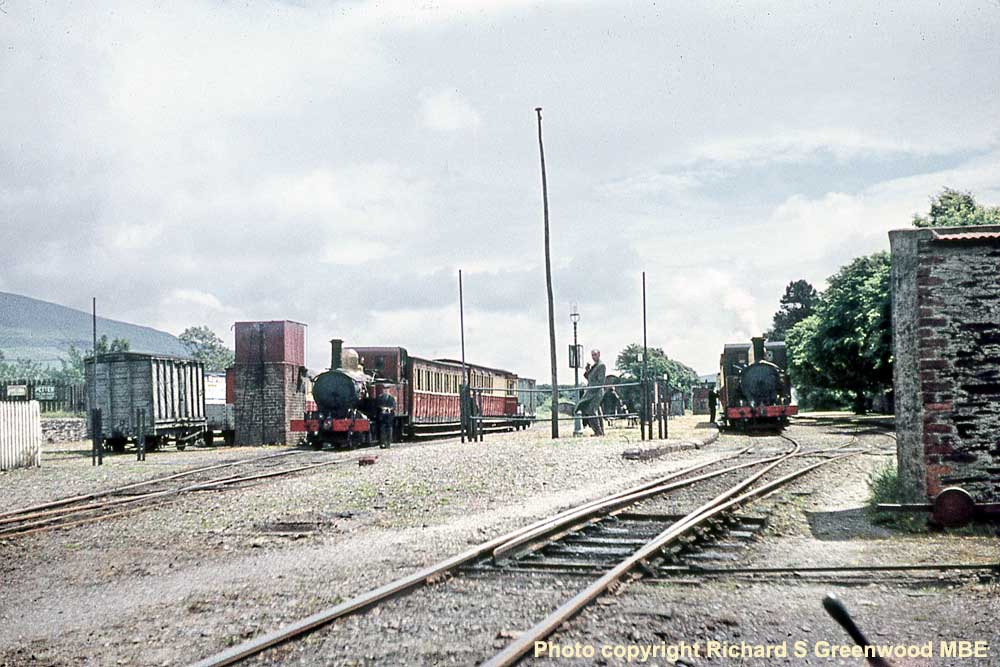

(Above-Below) No 10 'G H Wood' is at the head of a Peel train in the platform at St John's. (Below) This map section of the Isle of Man circa-1946 has been scanned, cleaned and digitised from an old, out of copyright original by The New Society for the Diffusion of Knowledge (NSDK)...the full map can be found on the Society's excellent website HERE.


(Above-Below) The last locomotive built for the Railway entered service in 1926 and was noticeably larger than the rest with a more conventional cab. This is No 16 'Mannin' ready to depart with a short train to Peel. By this date the pressure of its original boiler had been reduced and it was employed on light duties. (Below) No 13 'Kissack' has a Ramsey train at St John's ready to depart.


(Above-Below) On another date No 13 'Kissack' arrives from Ramsey; note the saloon coaches in the sidings to the right. After I took the photograph No 13 drew ahead, set back and coupled onto the saloons before setting out for Douglas (below). Locomotives always worked chimney first from Douglas.
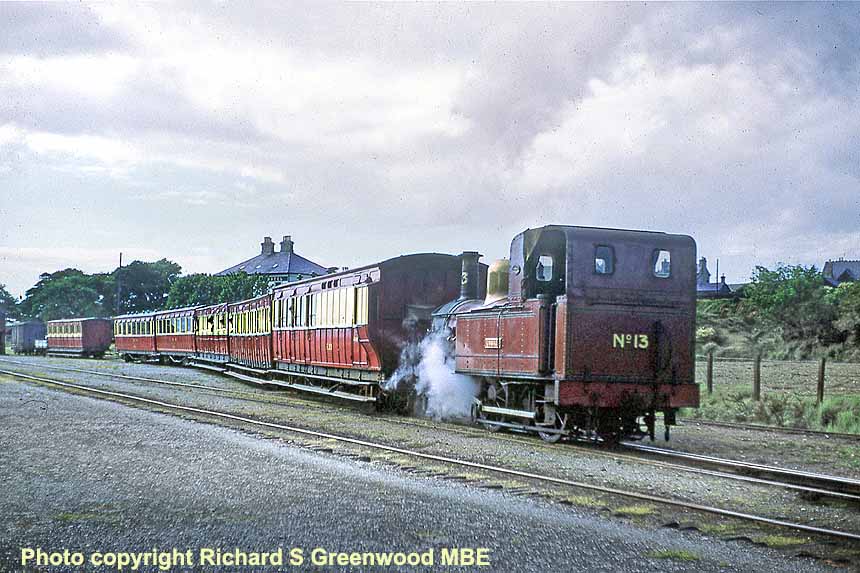
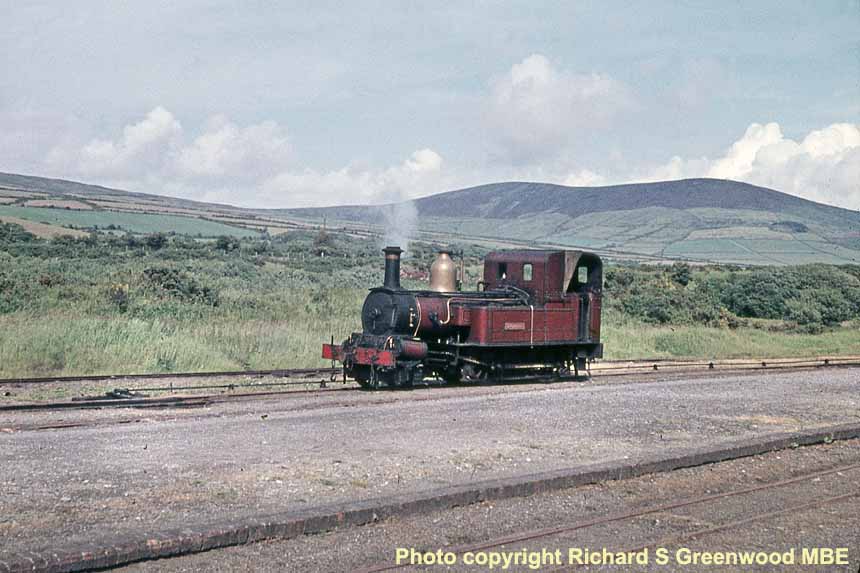
(Above-Below) Some idea of the idyllic country setting of St John's station in typical Isle of Man scenery can be gathered from this shot of No 14 'Thornhill', appropriately an ex-Manx Northern loco, waiting at St John's to take over a Ramsey portion in 1964. For those more interested in things mechanical than scenic, below is a close up of the locomotive.


(Above-Below) This is another occasion at St John's in 1960; a snatched shot looking back from a Peel train departing St John's with No 14 'Thornhill' not far behind with the Ramsey portion. The Peel and Ramsey lines separated just beyond the level crossing at the west end of the platforms. (Below) A Peel train sets out with an assortment of old coaches...the Ramsey line parallels it on the left.


(Above-Below) No 6 'Peveril' with a one coach train for Peel is seen a short distance further west. (Below) No 8 'Fenella' climbs away above the Peel line with the main train bound for Ramsey.

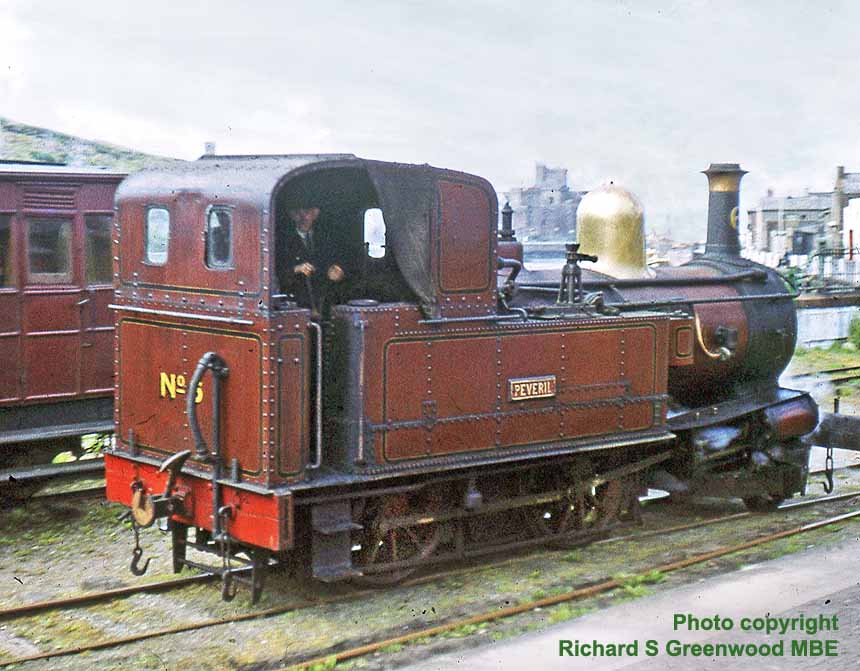
(Above-Below) Now a single shot at Peel of No 6 'Peveril' as it runs round. On the skyline can be seen Peel Castle which is situated on St Patrick's Isle with a causeway to the mainland. The maroon coaches in the background were not normally used on the ordinary trains. (Below) Unfortunately I have no colour photographs taken on the Ramsey line so we turn to the Port Erin Line, now in 2014, the only line still operating. Descending the steep gradient into Douglas one morning with three coaches and two vans is an unidentified locomotive.


(Above-Below) An idea of the countryside can be gained from this photograph taken from the train near Santon. Ballasalla was a splendid photogenic spot for afternoon down trains. (Below) No 10 'G H Wood' enters the station with a train from Douglas.


(Above-Below) A few years earlier No 12 'Hutchinson' passes the water tower and approaches the level crossing at Ballasalla on 13 June 1960. (Below) No 12 'Hutchinson' is seen once again entering the station at Port St Mary. In 1960 we stayed at the Balqueen Hydro on the Promenade at Port St Mary…long since gone.


(Above-Below) This loco is seen yet again at Port Erin station about to set out for Douglas. (Below) Another Douglas departure prepares to depart from the same station behind No 13 'Kissack'. I recall the Isle of Man Railway using some kind of chemical weedkiller around their stations which had a somewhat unpleasant, lingering smell.
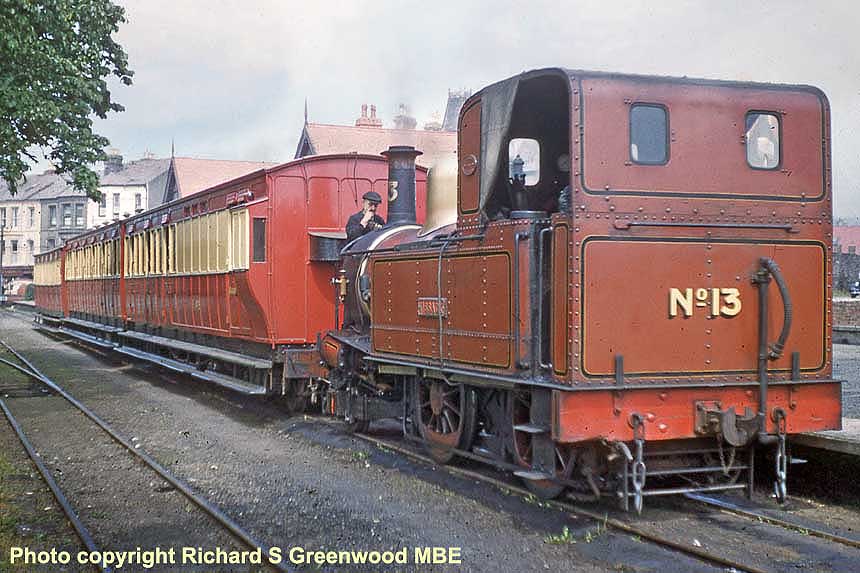

(Above-Below) As at Peel and Ramsey there was a small engine shed at Port Erin and No 5 'Mona' is being put away for the night. One of the most important colony of choughs (a species of crow) in Britain is to be found along the cliffs north of Port Erin. South of the island lies a much smaller island, the Calf of Man, which is a bird sanctuary and south of that an important lighthouse on Chicken Rock. We finish with a scenic shot (below) taken from Beach Road in June 1960; it shows a train from Port Erin to Douglas shortly after leaving Port St Mary...just visible on the skyline is Bradda Head which overlooks the bay at Port Erin.

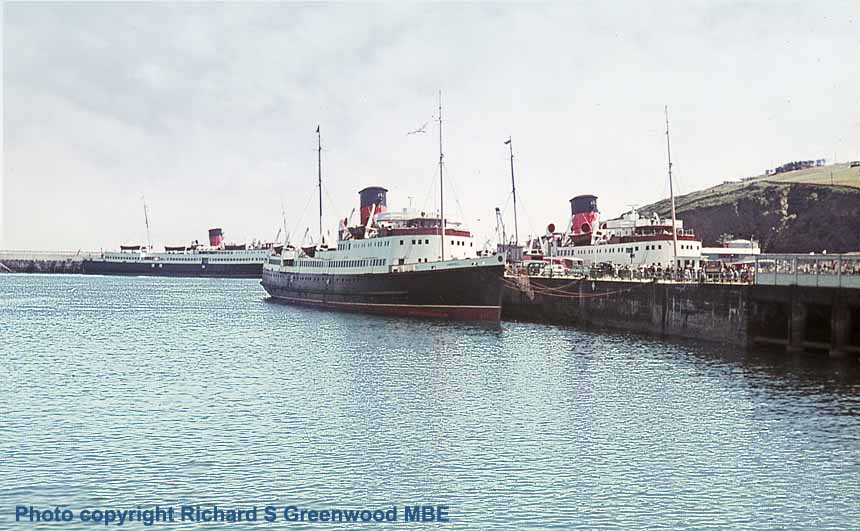
(Above-Below) Time to return home; tied up at the Pier at Douglas harbour are a couple of IOMSP boats plus a third tied up at Battery Pier. (Below) An Isle of Man passenger steamer heads up the Mersey past Clarence Dock power station. Efforts to preserve the last of this magnificent fleet, 'Manxman' built in 1955, failed and already semi-derelict it was scrapped in 2010 at Sunderland. Please note this is a super-wide image and you will need to 'click-on' twice (not double-click) to see the full-size image.


(Above-Below) A spinoff from the Isle of Man holiday was the opportunity to see some of the bigger ships in the Mersey, such as the Cunard liner, 'Sylvania' - another super-wide image - plus a close-up of the tugboat (below) and finally a shot of the Canadian Pacific 'Empress of Britain'.
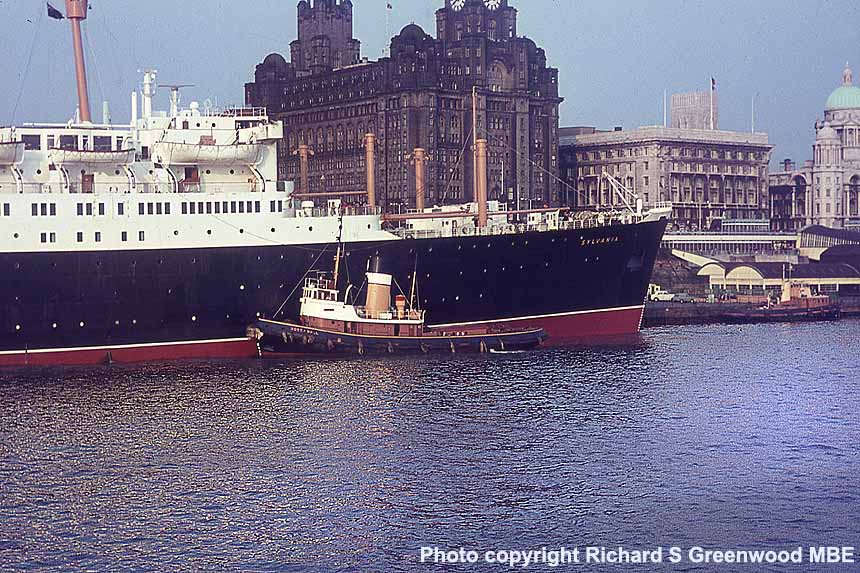
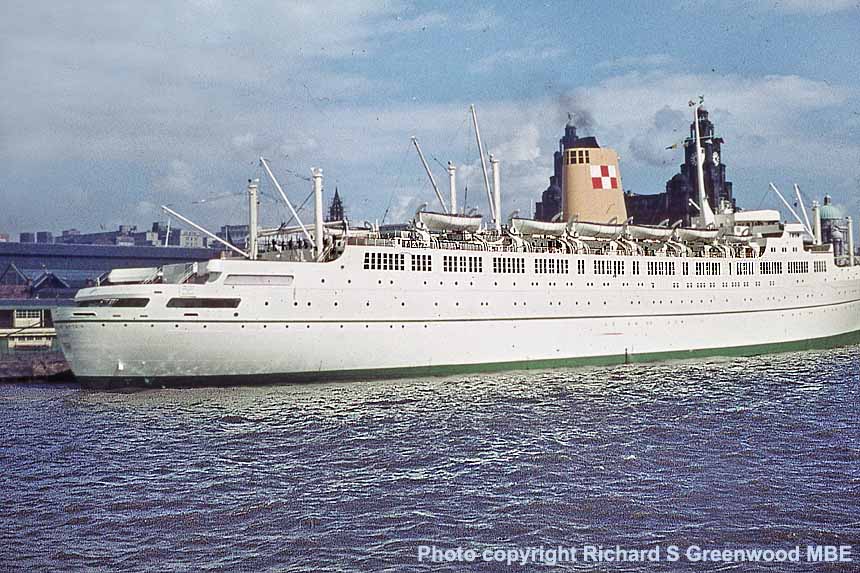
Isle of Man Holiday Tickets
The Booking Clerk at Smithy Bridge was proud of his 'LMSR Foreign and Saloon' tickets - 3rd class rail but Saloon on the boat. Strictly he shouldn't have issued them for a journey to Douglas but decided to anyway. The tickets had a little paper insert with adverts on (below).
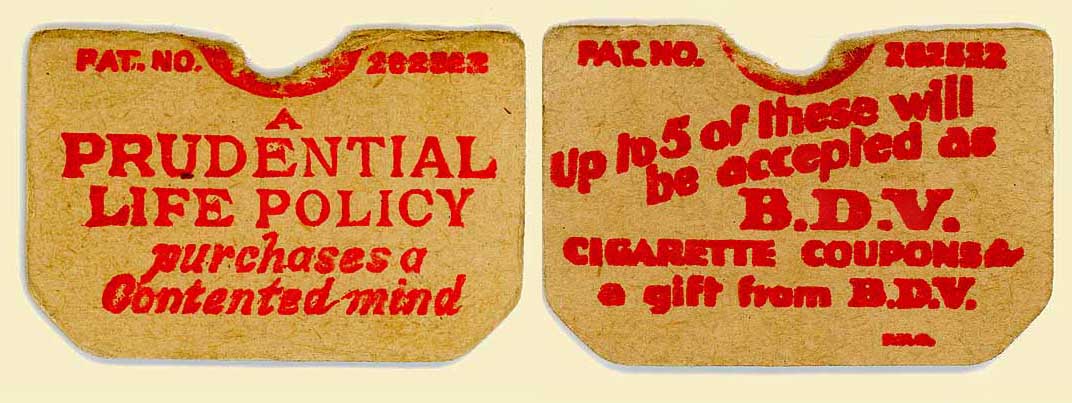
(Below Left) We resorted to a certain amount of subterfuge to avoid the halves being collected at the appropriate time. As our party of four passed through the barrier at Liverpool Exchange I remember the ticket collector remarking - 'There's a lot of very old tickets about today!' The ticket is dated 10 June 1960 but we travelled a couple of days afterwards. The fare is handwritten at 71/6d. That's seventy one shillings and sixpence or £3.58 decimal...

On the reverse side of the ticket (above right) are the terms and conditions which state - 'The Companies or Owners on whose Railways, Coaches or Vessels this ticket is available are not liable for any occurrence however arising off their own Railways Coaches or Vessels and their liability on their own Railways Coaches is limited by the conditions contained in their respective Timetables Bills & Notices which form part of the terms of this Contract. Included in the Steamship Owners' conditions is a provision that they are not liable for loss of life or loss or injury to Passengers or their luggage from whatever cause arising.'


NORTHERN IRELAND STEAM
My brother and I spent a couple of days in Northern Ireland from 28 June to 1 July in 1964, before going on to the Isle of Man for a few days. Northern Ireland Railways were in a parlous state. The main railways had firstly been the Great Northern Railway of Ireland several of whose lines including the main Belfast to Dublin route crossed the border, and secondly the Northern Counties Committee comprising the Belfast and Northern Counties Railway (once owned by the LMS) and other smaller Companies.
When the Great Northern Railway of Ireland - GNR(I) - went out of business in 1951 their lines both north and south were taken over and operated by a joint governmental Great Northern Railway Board until 1958 when the Board was dissolved and the assets were split. Eighty three locomotives including two Class S 4-4-0s went to the Ulster Transport Authority which had been formed in 1949 on the nationalisation of the NCC. The GNR(I)'s interest in the south became part of Coras Iompair Eireann (CIE). But the CIE ceased to use steam in 1963 and their three class S 4-4-0s were then transferred to the UTA.
Many lines had been closed and more were to follow but in the summer of 1964 in the north there were still a fair number of steam locomotives running. Passenger work was largely performed by the ex-GNR(I) class S 4-4-0s. In addition the ex-NCC class W 2-6-0s designed at Derby and based on the highly successful Fowler parallel boiler 2-6-4Ts of the LMSR and the class WT, a 2-6-4T version of the W class.
We sailed overnight from Heysham to Belfast and at Great Victoria Street station we found the usual Sunday excursion to Dublin in the hands of one of the fifteen ex-NCC class W 2-6-0s No 97 'Earl of Ulster'.
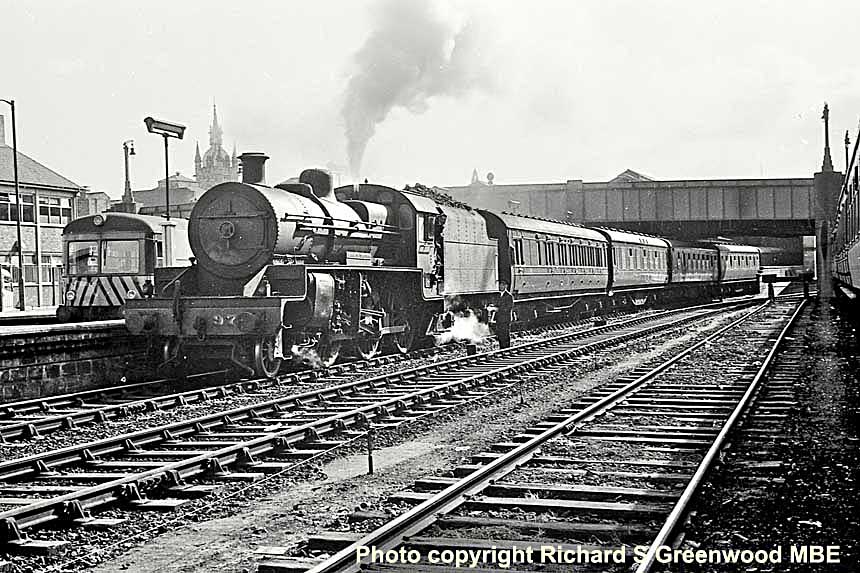
(Above) Ex NCC 97 'Earl of Ulster' waits at Great Victoria Street station Belfast. (Below) Somehow we'd heard that on 28 June there would be several excursion trains to Warrenpoint, the end of a freight only branch from Newry. So, we left the Dublin train there and boarded an excursion to Warrenpoint hauled by 174 'Carrantuohill' one of the magnificent ex-GNR(I) Class S 4-4-0s, a product of Beyer Peacock of Manchester in 1912. One of the class is preserved as a runner on the Irish main lines...No 171 'SlieveGullion'.


(Above) The whole class of five locos were named after Irish mountains. In 1964 these engines were still running in GNR(I) blue livery although their cleanliness left much to be desired. Nonetheless the blue could still be seen when the sun was shining and the letters 'G N' could be read on the tenders. We see No 174 at the platform at Portadown. (Below) The route was via Newry and at Newry South the train was stopped at the signal guarding a level crossing.


(Above) The S class locomotives only just fitted on the turntable at Warrenpoint with barely an inch to spare. Then it was a case of manhandling them round. (Below) No 174 is seen at the head of the empty stock at the platform.


(Above) At least one 0-6-0, UG No 49, was used on one of the Warrenpoint excursions. (Below) A second Class S 4-4-0 No 170 also brought in another excursion.
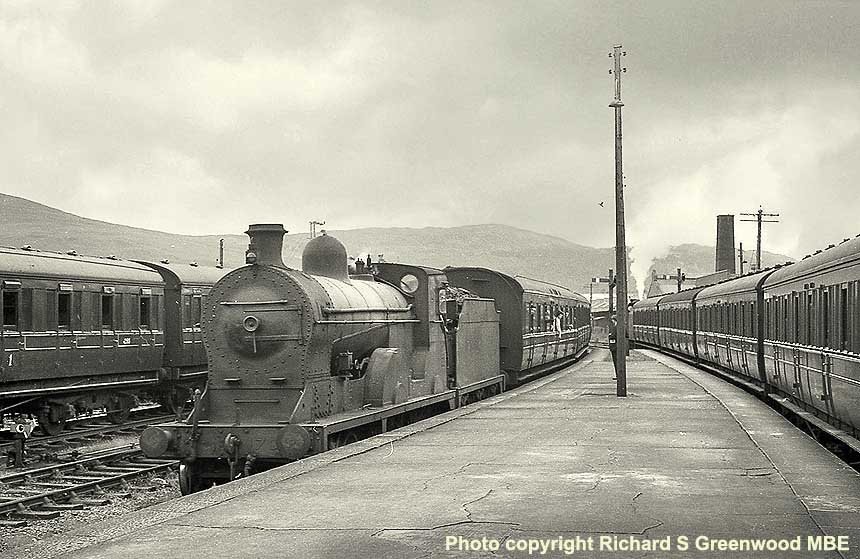

(Above) No 170 also successfully accomplished the visit to the turntable. (Below) Both Class S 4-4-0s in the station yard awaiting their return journeys.

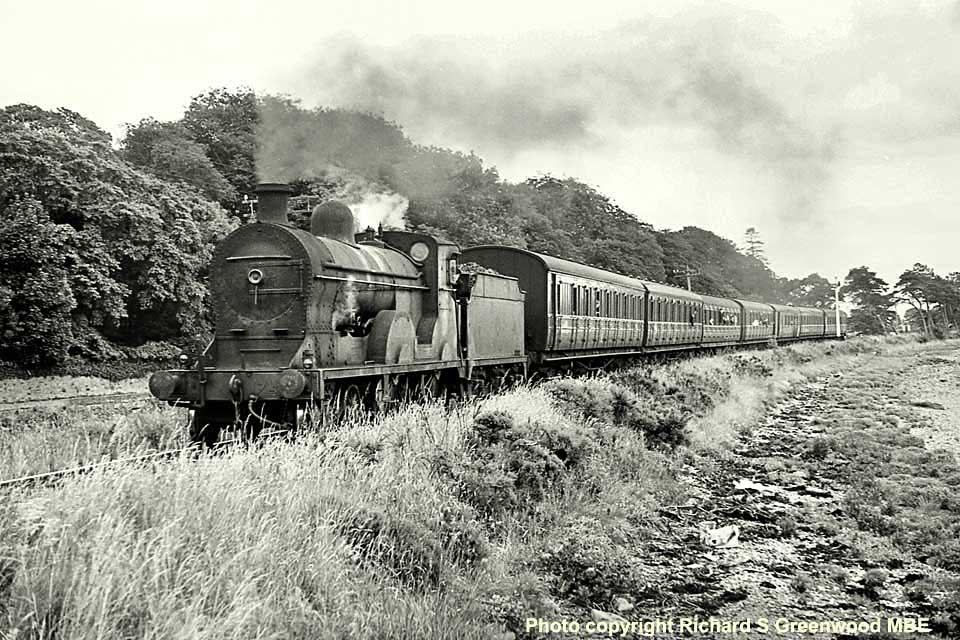
(Above) At Warrenpoint we met a friend on holiday with his parents and he had his car with him. This enabled us to leave the station environs at Warrenpoint for other viewpoints. We didn't have long to wait as No 174 was seen passing Narrow Water Castle en route back to Newry. (Below) We managed to overtake it in time to get another shot of it at Newry Monaghan Street.


(Above) By now the sun was shining so a visit to Portadown shed was called for. The shed was a rather modern looking concrete three-quarter roundhouse. Seen in the stalls are a couple of Class Ws No 91 'The Bush' and 99 'King George VI', plus a WT 2-6-4T No 57 and an SG3 0-6-0 goods engine No 33. (Below) Other locomotives in light steam ready for the Monday morning traffic were a U class 4-4-0 No 66 named 'Meath' built as late as 1949 by Beyer Peacock, WT No 8, and an ex-GNR(I) class SG2 0-6-0 No 43. Apart from the W and WT class all the locomotives were ex GNR(I).




(Above) There followed a Monday with little railway interest (as the Giants Causeway Electric Tramway had long been abandoned) but inside the apparently derelict GNR(I) loco shed at Londonderry we found class W No 99 'King Geoge VI' which was in the Portadown roundhouse the day before. It had obviously arrived on a freight. (Below) A second loco, SG3 0-6-0, that we had seen the previous day at Portadown, was engaged on shunting the yard. The GNR(I) passenger service to Londonderry from Portadown via Omagh and Strabane had already been withdrawn.


Pics 018 019 (Above) On Tuesday a journey by bus to Belfast and a hurried walk to Great Victoria Street saw us making the Dublin train by the skin of our teeth! We scrambled aboard the carriage accompanied by shouts of - 'Hold the train, two passengers for Portadown...' There couldn't be many places in 1964 where you could find 4-4-0s at work and the station pilot at Portadown was U class 4-4-0 No 68 'Down'. (Below) When the midday Belfast to Dublin train rolled in it was in charge of Class WT No 53 with a steam loco tender attached. The idea was to enable the WTs to run the full 108 mile distance between Belfast and Dublin without having to take water en route. Although the CIE was fully dieselised, steam locomotives from the north continued on the Belfast trains for some time yet. But the experiment was short lived and not considered a success.
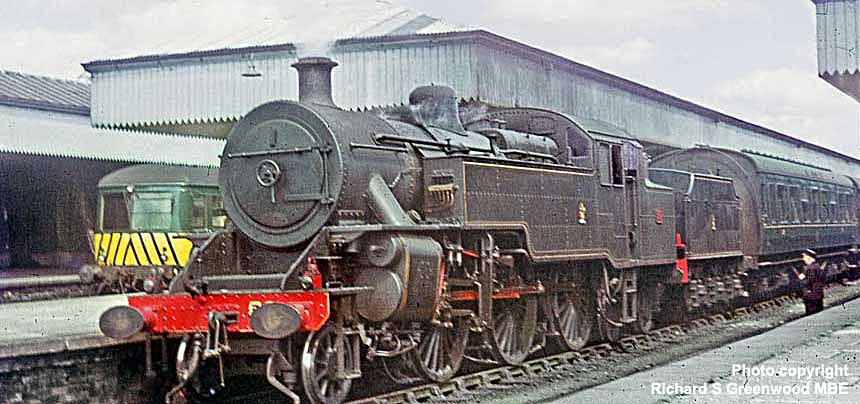

(Above) A long northbound freight left Portadown behind a Class WT 2-6-4T No 8. (Below) As we made our way by train northwards towards Belfast we encountered the same freight at Lisburn.


(Above-Below) Now two southbound passenger trains at Lisburn, WT No 54 on a train of CIE coaches with a train for Dublin and another WT No 1 (below) on a stopping train.


(Above) One of our friends from Sunday was this ex-CIE Class S No 170 'Errigal', seen here at Dunmurry on a southbound passenger train. (Below) Inside the shed at Adelaide is one of the large three cylinder Class VS 4-4-0s of the GNR(I) No 209 'Lagan', unfortunately out of steam.


(Above-Below) Other scenes taken on the shed that day include these evocative shots of working steam locomotives in the traditional setting of a steam shed now long since gone but fondly remembered.


(Above) Another class S is seen in this three-quarter rear view as it departs from Adelaide station towards Portadown. (Below) A distant view of the return daily excursion train from Dublin with an unidentified class W in charge.


(Above) Last shot of the evening of 30 June 1964 captures a Class S returning light engine to Adelaide shed. (Below) The following morning there was a procession of four steam hauled commuter passenger trains to and from Belfast, beginning with a tender-first Class S…


(Above-Below) The Class S was followed by Class UG 0-6-0 No 47 (above) and another old friend WT No 1 (below)…


035-036 (Above) Unsurprisingly the last train was hauled by yet another Class S; these 4-4-0s were so frequently used it was difficult to believe that there were only five of them. (Below) The only locomotive which was neither ex-GNR(I) nor ex-NCC, was 0-6-4T 'Lough Melvin' of the former Sligo, Leitrim and Northern Counties Railway, absorbed into UTA in 1949. This was yet another Beyer Peacock product having been built in 1949. It was shunting at the UTA works at York Road Belfast.

(Below) We end our visit with a nostalgic shot of 1960s cars parked in the Works Car Park as 'Lough Melvin' continues its shunting duties. Then it was off to the Airport for the short hop to the Isle of Man in a Vickers Viscount of Cambrian Airways.

KENYA 1978
Following the end of BR steam in 1968 not many railway enthusiasts visited Kenya, even though a good number of steam locomotives were still working even as late as June 1978. During our visit several steam classes were operating the main line from the port of Mombasa on the Indian Ocean to Nairobi and to Kampala in Uganda. Steam action could also be found on two other lines from Nakuru to Kisumu and onwards to Butere plus the line from Voi to Taveta. However at the time of our visit the border between Kenya and Tanzania was closed, therefore the line from Voi to Taveta and onwards across the border to Moshi in Tanzania saw very little traffic.
Conceived in 1896, construction work of the line from Mombasa to Uganda commenced in a somewhat half-hearted fashion since the company was using second hand equipment from India. This explains why the gauge of 1 metre was adopted rather than the 'Cape' gauge of 3 feet 6 inches; the latter gauge being the proposed standard system all the way from the Cape of Good Hope to Cairo. During construction the railway engineers encountered many setbacks, including flooding, sickness and the need to negotiate the steep escarpment into the Rift Valley - not to mention platelayers being devoured by lions - but the line eventually reached Kisumu in 1901. From Kisumu the connection to Uganda was by boat on Lake Victoria. Kampala was not reached by rail until 1931. The history of building the line and much else can be found in the voluminous 559-page book 'The Lunatic Express' by American author, Charles Miller published 1971...highly recommended.
From Mombasa the line traversed the coastal tropical area as far as Nairobi's scrubby desert; the company established its main workshop at Nairobi on account of a plentiful supply of fresh water, beyond which the line traversed the lush agricultural area. The railway was originally operated by the Uganda Railway, then the Kenya Uganda Railway, next the East African Harbours Railway and finally Kenya Railway. The distance from Mombasa to Nairobi is 275 miles and the altitude at Nairobi is 5,890 feet above sea level. In the twenty six years since our visit the population of Nairobi has increased six fold to over three million.
Beyer-Garratt articulated steam locomotives were introduced on the line in 1930, but by 1978 only two classes survived: the 60 class with a wheel arrangement of 4-8-2+2-8-4, built by Beyer Peacock of Manchester in 1953-1954; these locos weighed 152 tons with a tractive effort of 43,520lb. But the class was overshadowed by yet another Beyer-Peacock-built Beyer-Garratt - the 59 class - of the same wheel arrangement, but weighing in at no less than 251 tons. With a tractive effort of 83,350lb the 59 class was the most powerful steam locomotives ever built for such a narrow gauge; they were capable of hauling bulk freight trains consisting of twelve 100 ton wagons on the Mombasa-Nairobi main line which had gradients as steep as 1 in 60 in some places.
By 1978 all steam locomotives used oil fuel and the larger locomotives were fitted with Giesl exhaust ejectors which increased their haulage capacity due to the reduction in back pressure on the pistons. Apart from the class 59 and 60 Garratts, four other classes were still in use; these included the class 29 2-8-2 tender locomotives built by North British at Glasgow in 1951-1952, the class 31 2-8-4 tender locomotives built by Vulcan at Newton-le-Willows, and a handful of 4-8-4T shunting locos built by Bagnall of Stafford in 1950. However, the class described as 'the most successful steam locos ever built for East Africa', namely the class 24 4-8-0 tender engines, were regularly seen during our visit. Built between 1923 and 1930 by Vulcan Foundry and Nasmyth Wilson of Patricroft, the locos were primarily used on lightly laid branch lines.

(Above) A view of part of the running shed at Nairobi, albeit in a somewhat dilapidated state with one of the class 13 4-8-4Ts prominent alongside an unidentified 60 class. At this time Nairobi loco works was converting boilers from the withdrawn 60 class locos for use in sugar refineries. (Below) Alongside Nairobi shed, we see one of the oldest class of locos, No 2814 just ex-works on its acceptance trials. The gentleman in the turban was at that time the Chief Locomotive Inspector. The pristine paintwork has been burnt at two places where the cab roof joins the cab side. No doubt the Chief Loco Inspector had requested some modifications.


(Above) No 2406 of the same class is seen inside the shed building at Voi. (Below) The following day No 2406 was in charge of a ballast train on the branch towards Taveta. We were very fortunate to see a train on this line which ran through the grounds of the Holiday Lodge where we spent the night disturbed throughout by the croaking of frogs! Three further photographs give an idea of the type of countryside the branch ran through.

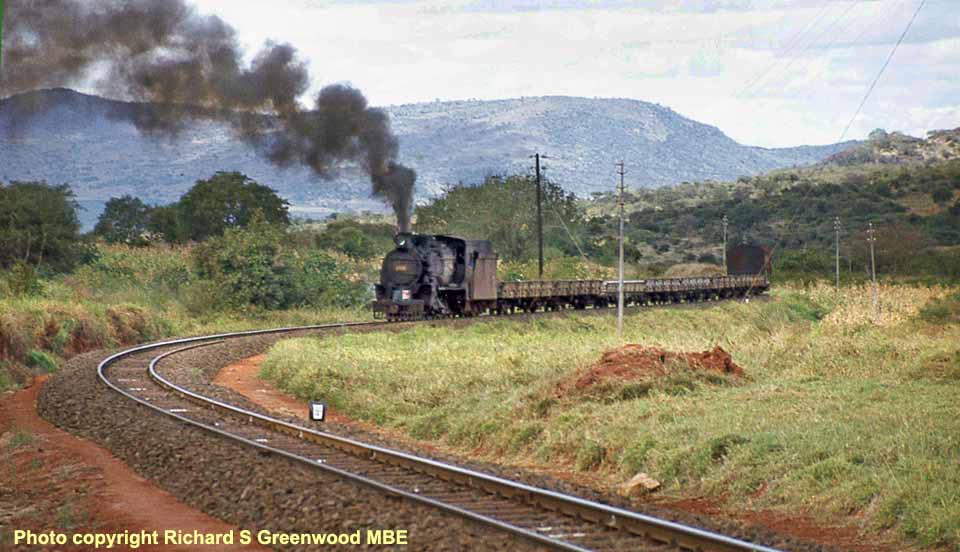



(Above) In Voi shed yard one of the two smaller Garratts, class 60 No 6023 was on shed. (Below) No 6013 of the same class, is partially hidden in the shed where 2-8-4 No 3120 is about to emerge.


(Above) 3120 is now in the shed yard and being lit up...clearly visible is a cloud of blue haze of smoke and fumes, as is so often the case when lighting up an oil fired engine! (Below) The loco machine shop at Voi was open at the sides, protected only by a wire mesh; we noted three machine tools in use, all manufactured by British firms based in Hebden Bridge, Halifax and Keighley. The pilot on this occasion was another class 13 4-8-4T No 1317.


(Above) Two super-wide images, starting with this head on shot of No 5915 at Voi which accentuates the size of the huge 59 class machines compared to the track gauge. (Below) Voi was a watering and fuelling point for the mainline trains. In this shot a 59 class is taking water from the water crane at the front and oil fuel into the fuel tank where the shedman is controlling the valve.


(Above) There followed several other shots of the 59 class at Voi: the first one showing No 5901 restarting its train of oil tank wagons. (Below) Both front and rear views of another 59 class taking fuel, while the final shot in the sequence is an interloper...an English Electric diesel draws up alongside.





(Above) In the coastal tropical strip near Mackinnon Road, a block train of 1200 tons is in charge of the inevitable 59. (Below) Moving up to the desert section, another view of a 59 at one of the passing loop stations. One of these stations is named 'Simba' - Swahili for 'Lion'. At Tsavo station, just north of Voi at the entrance to the Tsavo National Park, we found a partly constructed building - possibly a Hotel or Visitor Centre. Since the work had never been finished the abandoned building had been colonised by a large troop of baboons, and the station staff warned us not to leave any items about as the baboons were master thieves.

(Below) Carrying such heavy trains with an axle loading of 25 tons per axle on the wagons and 20 tons per axle on the locomotives meant that the trackwork had to be extremely well maintained...immaculate is the words that springs to mind. This can be seen in these two photographs of a class 59 approaching the camera and then going away. The undulating nature of the line is well illustrated. Note also the smoke in the distance; this is from a train going in the opposite direction setting out from the passing loop.
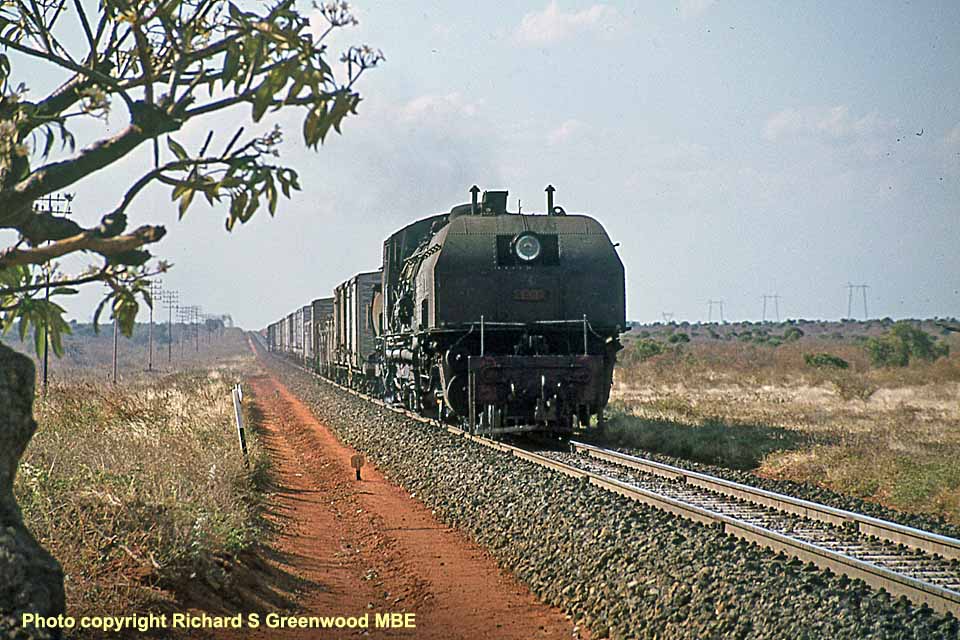


(Above) I think this shot is at Nakuru - but after 35 years, the memory may be faulty. It shows one of the North British 2-8-2s No 2920 (Below) A freight hauled by a class 29 No 2917 is seen north west of Nairobi in the 'White Highlands'. It is climbing towards Limuru before descending into the Rift Valley.
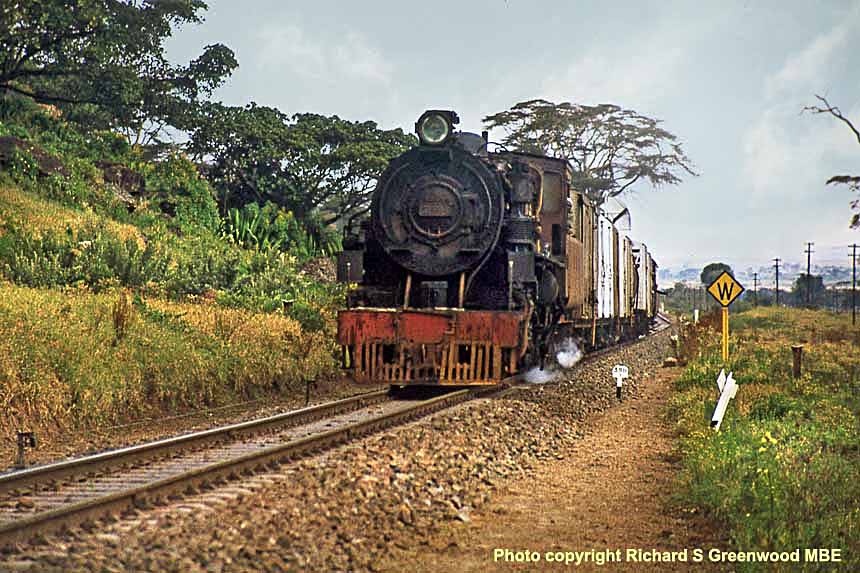

(Above) We travelled second class sleeper from Nairobi to Kisumu where we found a class 31 No 3124, acting as a shunting engine marshalling the only steam worked passenger train at that time in Kenya. This was the branch train to Butere making a daily round trip. The smokebox door clearly used the same dies as those for Stanier LMS locos. On our return to Nairobi there was a Kenyan gentleman in our six berth sleeping car compartment who was met on arrival at Nairobi by the police. I found out later he was a prominent member of the Opposition Party. The breakfast menu on the train was very English (Below) Another view of 3124 at Kisumu.
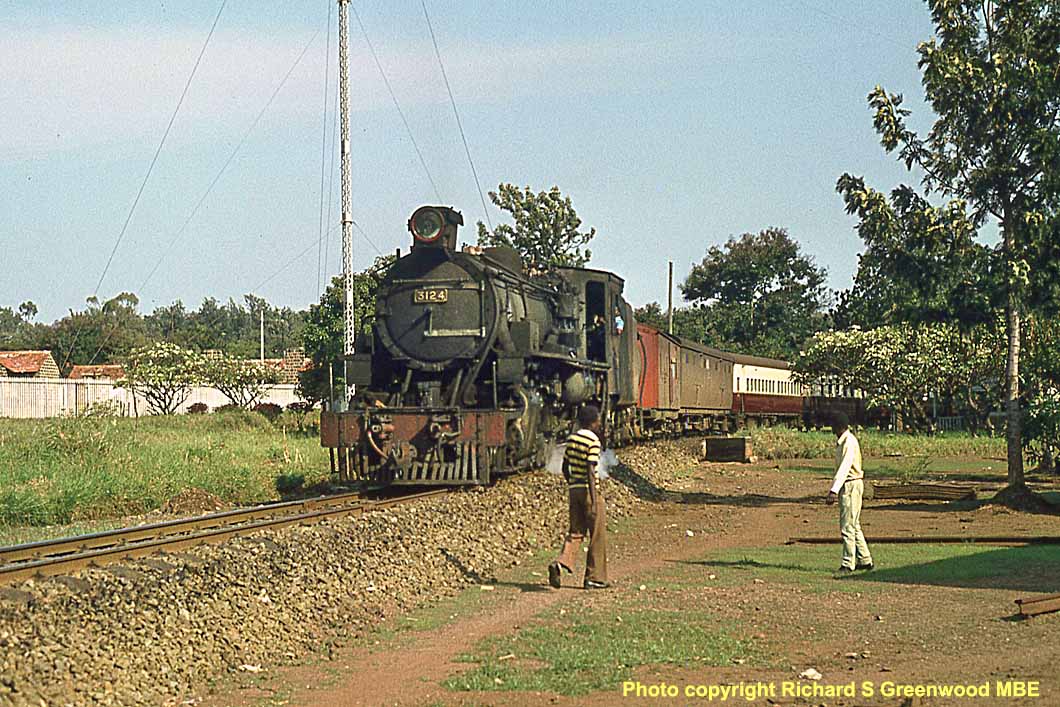

(Above) Locomotive No 3126 was in charge of the train on the Butere line which crosses the Equator as it travels through a very fertile agricultural district. The passenger service was discontinued some years after our visit but recommenced in 2007. When the Kisumu stationmaster found that he had party of European visitors intending to travel, he had an old saloon brought out of the sidings and attached to train for our sole use. (Below) Another view of the Butere train at a wayside station as it takes water. The engine crew gave us all long rides on the footplate.


(Above) Another view of the locomotive in this colourful location. (Below) Just to feel at home here are two views of Leyland buses at Nairobi railway station...


AUSTRIA
I visited Austria on three occasions: 1966 on an organised trip, 1967 for a few days and in 1973 also for a few days. The following album shows the different types of steam locomotives gainfully employed on both standard and narrow gauge lines.

(Above-Below) Much of Austria is very mountainous so many narrow gauge railways were constructed after 1889. The best known is the Zillertalbahn with a gauge of 760mm. It runs from Jenbach in the Danube valley to Mayrhofen a distance of 20 miles. Today most of the traffic is worked by diesels but a handful of 'U' class 0-6-2Ts survive for special workings. (Below) Another view of the Zillertalbahn taken in 1973 near Jenbach.


(Above-Below) The first narrow gauge railway was the Steyrtalbahn, opened between 1889 and 1909. This was also built to 760mm gauge and ran from Garsten (near Steyr) to Klaus, joining two standard gauge lines through the valley of the River Steyr. In 1966 locomotive No 298 102 still had the original style of chimney. Whilst it was still open throughout in 1966 and 1967, in the following year passenger trains ceased between Klaus and Molln. (Below) Locomotive 298 53 is at the terminus of Klaus with a mixed freight and passenger train in 1967.


(Above-Below) The line closed completely between 1980 and 1982 but a section has been preserved since 1985 between Steyr and Grunburg. (Below) In both 1966 and 1967 the traffic was worked by the U class 0-6-2Ts numbered in the 298 series with 298 53 built about 1898 being the most favoured locomotive.

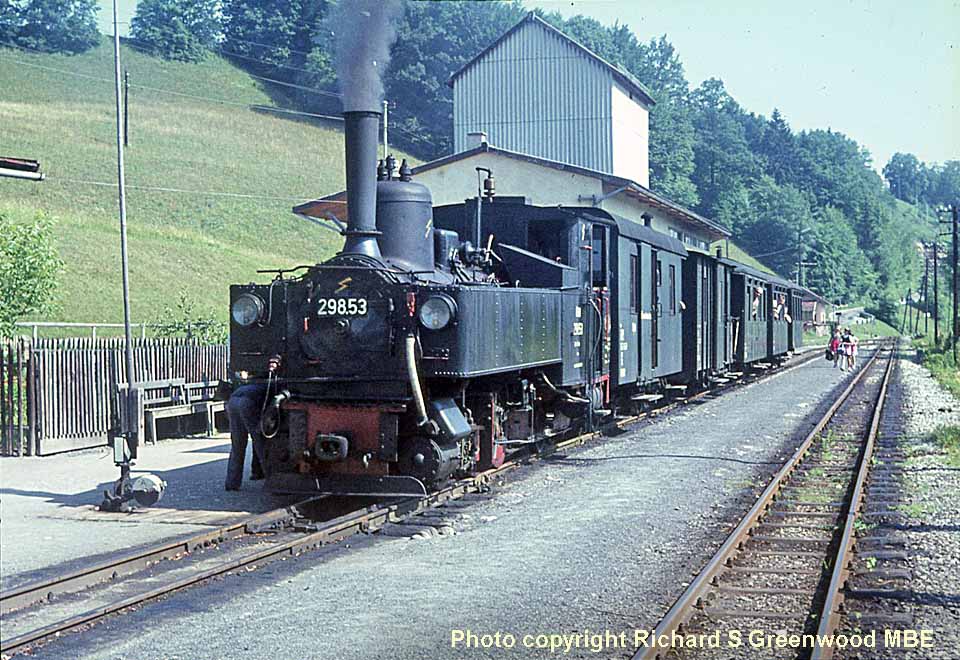
(Above-Below) The line ran through beautiful river valley scenery with several imposing stations. (Below) A view ahead from the footplate.


(Above-Below) By 1973 traffic was in the hands of a class 699 0-6-0T number 699 103 built in 1944. It was eventually fitted with a Giesl blastpipe and chimney, the height of the chimney being almost the same as the diameter of the boiler. Dr Giesl was an Austrian engineer who in the dying days of steam invented a blastpipe arrangement which permitted low quality coal to be burned. It was widely adopted in his home country. Other railway systems also used it. Even the oil fired Garratts in Kenya received it as the haulage capacity of the locomotives was some 10% to 15% higher due to less back pressure on the pistons. In Britain only one 9F 2-10-0 No 92250, and a 'Battle of Britain' Pacific 34064 Fighter Command were fitted. The Welsh narrow gauge line the Tal-y-Llyn Railway fitted a couple of locomotives. The privately owned 'West Country' class No 34092 City of Wells was also fitted as a means of preventing smoke drifting down obscuring the driver's vision. (Below) By 1973 passenger traffic was restricted to part of the line so 699 103 is taking freight vehicles only.
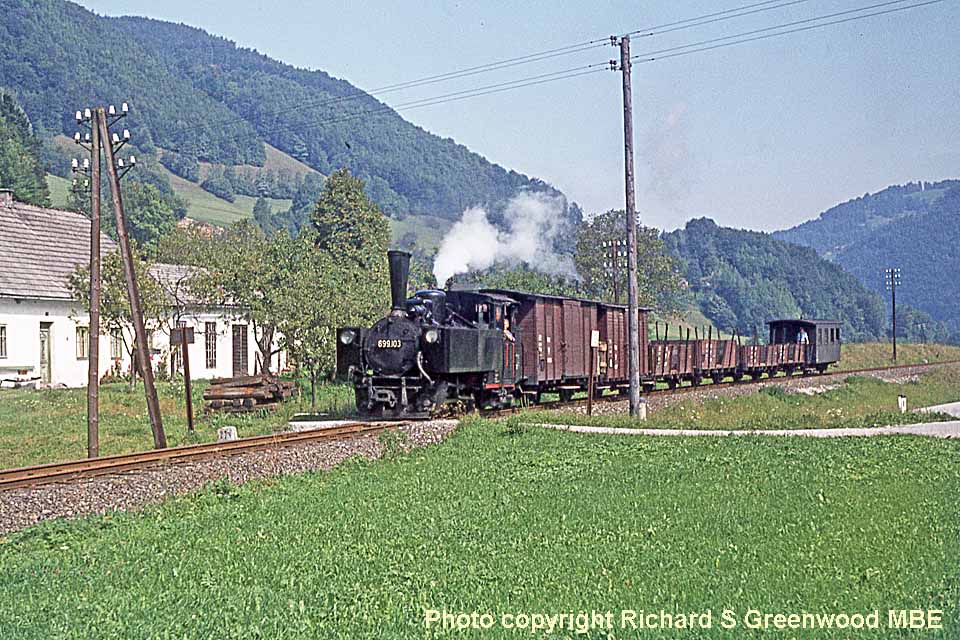

(Above) I make no excuses for including a couple more of this strangely appealing locomotive trundling over a rural level crossing amidst the beautiful Alpine scenery.


(Above) No doubt if any stray passenger had turned up they would get a ride in the coach at the rear of the train. (Below) An independent railway to the south of the country, the Graz Koflach Bahn (GKB) had built up a very varied roster of steam locomotives. Still shunting and working freights were a number of old two cylinder compound 2-8-0s of class 56 dating back to about 1914. In these views of the right-hand side of No 56 3190 shunting in the town of Koflach, the cylinder is the high pressure one and consequently of small diameter.


(Above) The locomotive then retired to the shed where we could admire the details so typical of locomotives of the old Austro Hungarian empire era (1867 to 1918). The Austrian locomotive designers, particularly Goelsdorf succeeded in producing powerful locomotives with low axle weights suited to secondary track and hilly terrain. (Below) Another of the class, number 56 3249 is working tender first on a train of logs.


(Above) Even today GKB still have a large collection of old, historic steam locomotives some of which can still be steamed. Seen in 1967, No 671 is reputed to be the oldest steamable locomotive in the world, having been built in 1860 and it was certainly steamed in 2013. (Below) Another old timer on the books is 4-4-0 415. Its design suggests it might have been older but it was built in 1897. Its last recorded steaming date is 2005.


(Above-Below) A 2-6-2T built in 1897 carrying its old Austrian Railway number of 30 39 and aesthetically a bit of a disaster, with a 'bits stuck anywhere' look about it. This view of the low pressure cylinder on the left hand side of the loco show it is noticeably larger in diameter. (Below) The GKB however had some modern power such as the class 152 2-10-0s. We see 152 309 complete with Giesl exhaust system and West German Railway (DB) 'trough' type smoke deflectors at Koflach shed.


(Above-Below) This shot demonstrates the 'bathtub' type of tender construction and a cabin in which the guard and shunters could ride. (Below) To complete the picture of this locomotive we have a shot of the front taken from inside the shed.

An aside on loco numbering. The ex-German locomotives left behind in Austria after 1945 were given a '6' prefix. So class 699 was really one of the many DR (German) class 99 - a number allocated to narrow gauge locomotives. Between 1938 and 1945 many locomotives were built in Austria to German designs and these were regarded as Austrian so did not receive the '6' prefix. Examples include class 50, 52 and 86. However the old Prussian G10 0-10-0 loco DR Class 57 became Austrian Class 657 (see inset right).
were regarded as Austrian so did not receive the '6' prefix. Examples include class 50, 52 and 86. However the old Prussian G10 0-10-0 loco DR Class 57 became Austrian Class 657 (see inset right).
Another aside. The Class 50s were to become the workhorse of Germany's railways. Introduced in 1939, as with all modern German classes, they had bar frames. Over 3,000 were built and, as with the British MoD WD locomotives as derived from Stanier 8F 2-8-0s, in order to simplify construction by being cheaper and quicker to build, from 1942 the German class 52 was introduced with plate frames and considerable welded fabrications. Almost 8,000 were constructed in various works in Germany, Austria, Czechoslovakia and Poland. After 1945 numerous examples of Class 52 were to be found in Austria, Turkey, Poland and several other countries although they did not remain in traffic in West Germany after 1963, but in the Eastern Zone they lasted a bit longer. However when West German Railways computerised their steam locomotive numbering system, the old 50 class was still so numerous that they had to be given 050, 051, 052 and 053 prefixes. This has misled some people to think the computerised class 50 locomotives renumbered in the 052 series were the original 52 class. GKB rostered locos of both the original 52 class and the modernised bar frame variant, class 152, which I think was peculiar to Austrian Railways.
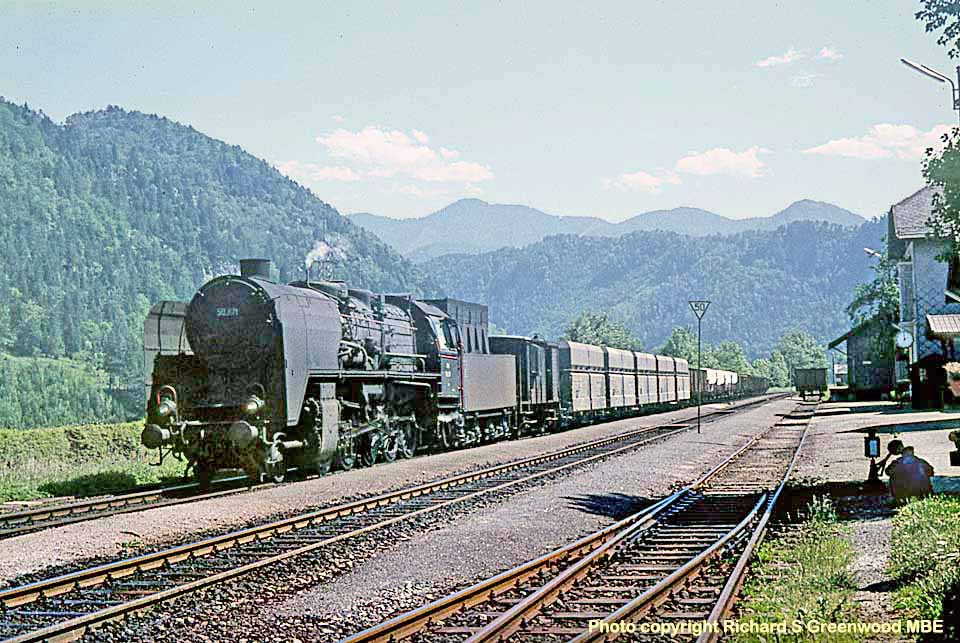
(Above-Below) An Austrian State Railways (OBB) example of the 50 class, number 50 1171 is seen at Steyrling in June 1967. It has the full height smoke deflectors of the 1930s and 1940s and a conventional tender although the sides have been extended upwards with 'greedy boards'. (Below) And another view. In 1972 this particular locomotives went to the GKB and is reported to have been active there until 1994.
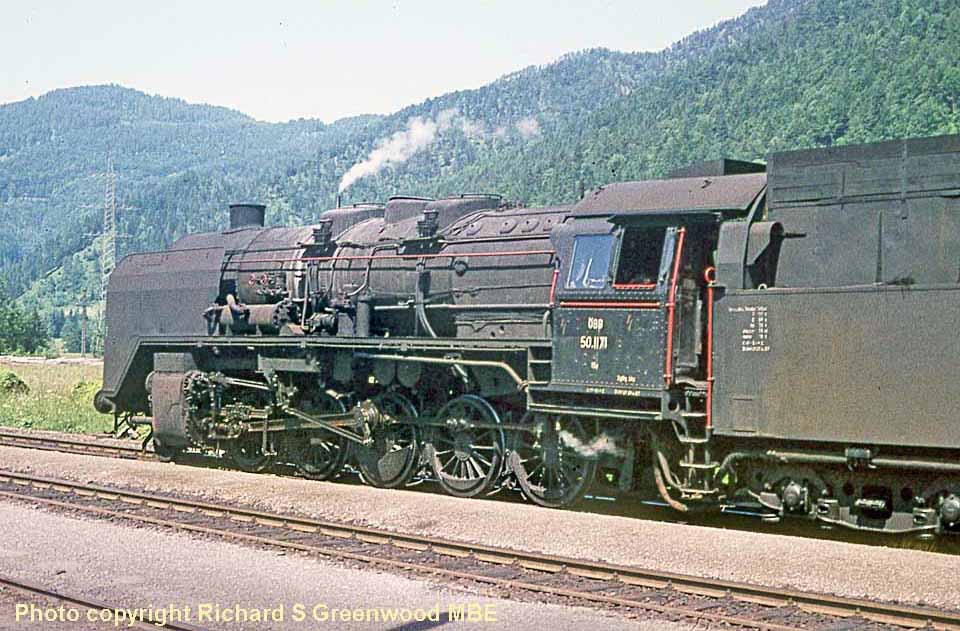
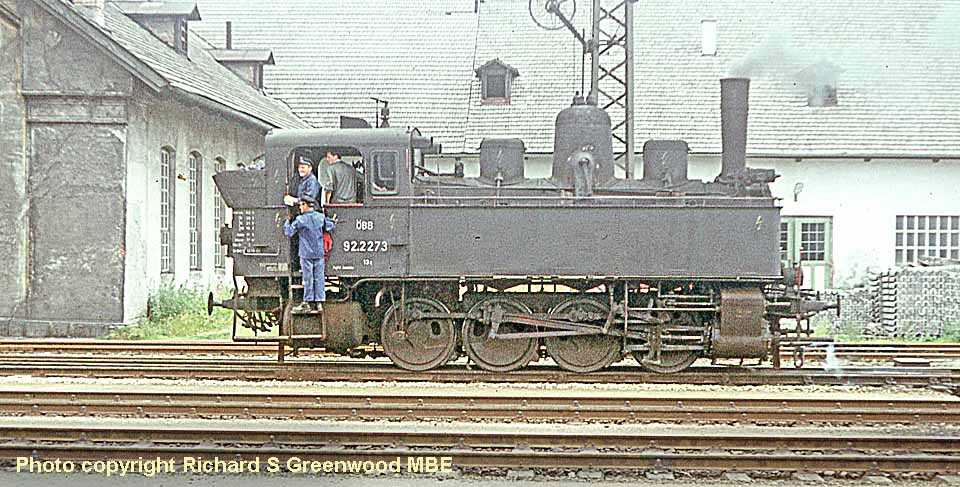
(Above-Below) Another ancient locomotive seen in 1966 was 0-8-0T No 92 2272 a design dating back before 1900. (Below) Not quite as old, having been built in the early years of the twentieth century were the class 77 4-6-2Ts. They were still working many of the local passenger trains in the Linz and Amstetten areas in 1966. No 77 21 is being prepared on shed. The height of the locomotive is emphasised as it drawfs the driver doing his oiling round.
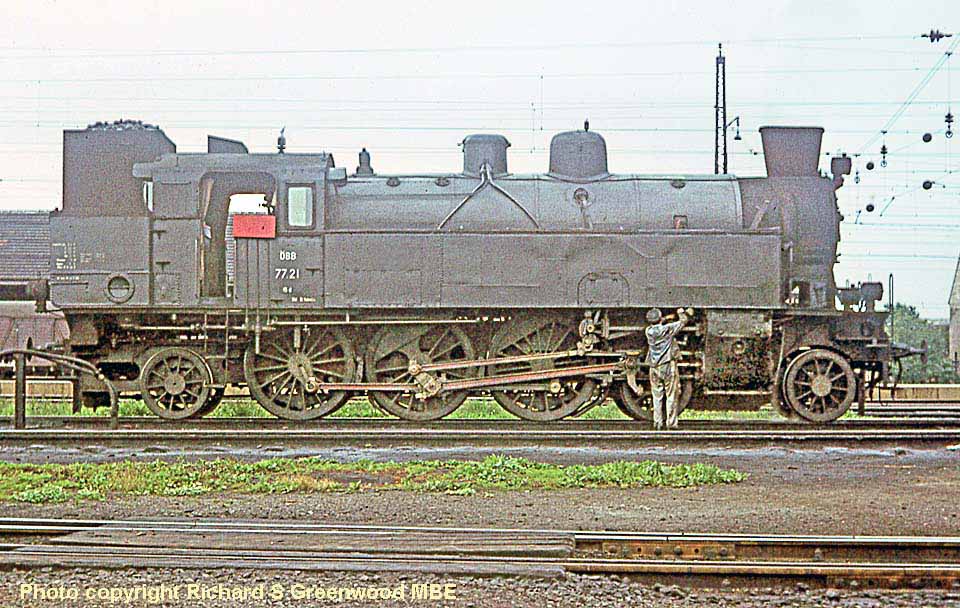

(Above-Below) The sun has come out as the same locomotive heads a train of four wheel passenger carriages across a level crossing. Austrian Railway continued to use four wheel carriages long after they had disappeared in Germany where they had been replaced by six wheelers. (Below) Another member of the class, 77 15 simmers at a suburban station.


(Above) There was no class of locomotive in Germany similar or equivalent to the 77s but there were various 4-6-4T classes in the 78 number series. Here we see one of the Austrian class 78s built in the 1930s , No 78 619 at the head of a passenger train in 1967 between Hieflau and Seltztal (Below) The OBB rostered a large number of class 52 (see above) as their standard freight and mixed traffic locomotives, often using them on passenger trains. Some of them were still in original condition in 1966 as was 52 7597 when seen ex-works at Linz.


(Above-Below) This locomotive, number 52 3816 has received the 'trough' type smoke deflectors (as were fitted by British Railways to some ex-LNER class A3 locomotives in the 1960s) but retains the original chimney. It is on a long, mixed freight in the Selztal area where the railways are mainly single track and hemmed in narrow valleys between the mountains. (Below) Many of the class such as 52 3315 received Giesl exhaust systems and chimneys as well as smoke deflectors. This shot is at Leoben on one of the electrified main lines in June 1967.
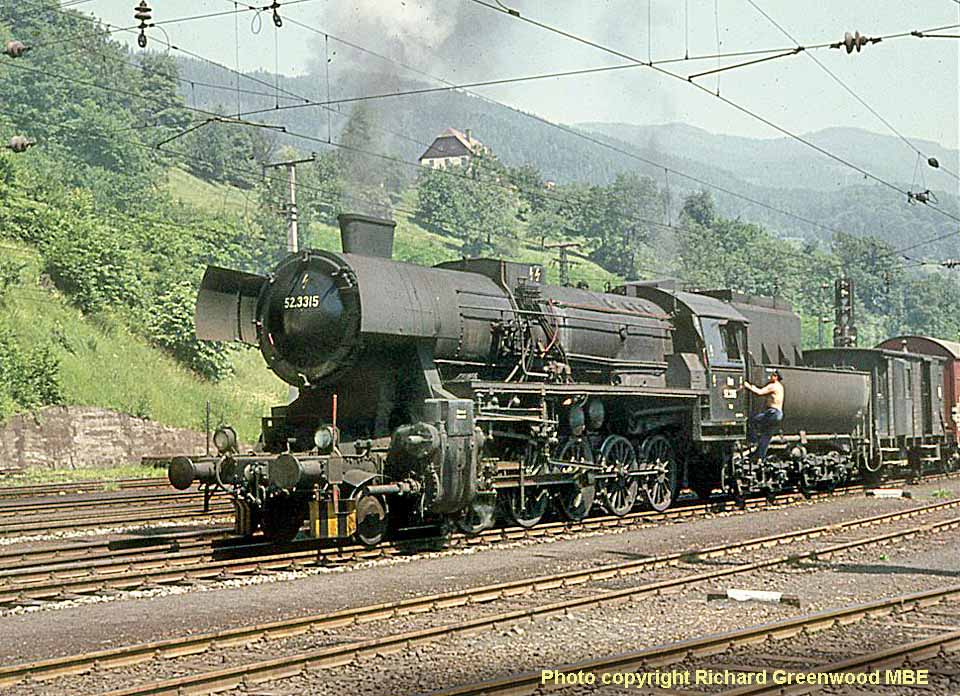

(Above-Below) Not many miles north of Graz was a standard gauge line notable for steam interest and scenery. This was the rack incline from Vordenberg to the summit at Praebichl where extensive iron ore deposits were worked. The line continued down the other side of the mountain to Eisenerz. (Below) No 97 205 is on the turntable at the shed at Vordenberg showing a wealth of detail of a very complex machine and track layout June 1967.


(Above-Below) Motive power was almost exclusively the class 97 2xx 0-6-2Ts of a 1908 design but a trio of twelve coupled tanks 97 3xx were built in 1912. Three passenger trains a day each way completed the whole length of the line but there was a more frequent shuttle service on the short stretch to between Vordenberg and Vordenberg Market. (Below) Passenger trains were propelled up the gradient.

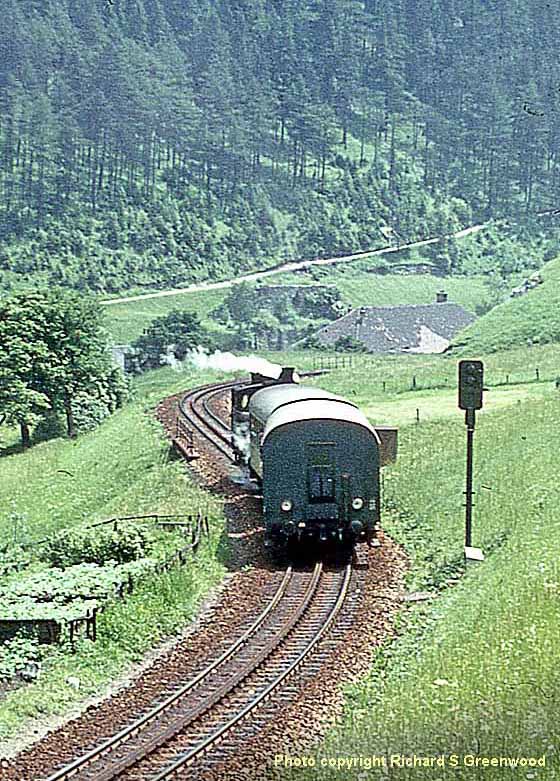
(Above-Below) Note there seems to be no provision for anyone to look forward when propelling but the noise and thunder of a slow moving, ascending train would surely be sufficient warning. (Below) One of the shuttle trains with 97 207 approaches Vordenberg Market station and a train of descending empties can be seen awaiting its turn on the single line.


(Above-Below) 97 205 on the local shuttle stands at Vordenberg Markt station. (Below) Empty wagon trains ascending the gradient were usually top and tailed (in modern parlance) for the journey up the mountain.


(Above-Below). A view of the leading locomotive from the road over the pass. Note the hopper on the cab roof for coal loading. And note also the venerable road motor coach descending the pass. (Below) The road paralleled the railway up the ever narrowing valley, and this is a shot of a short loaded train descending towards Vordenberg.


(Above-Below) Nearing the summit snow still lingers on the mountainside into the summer. (Below). One of the three 0-12-0T locomotives stands at the summit after arriving with a train of empties in June 1973.
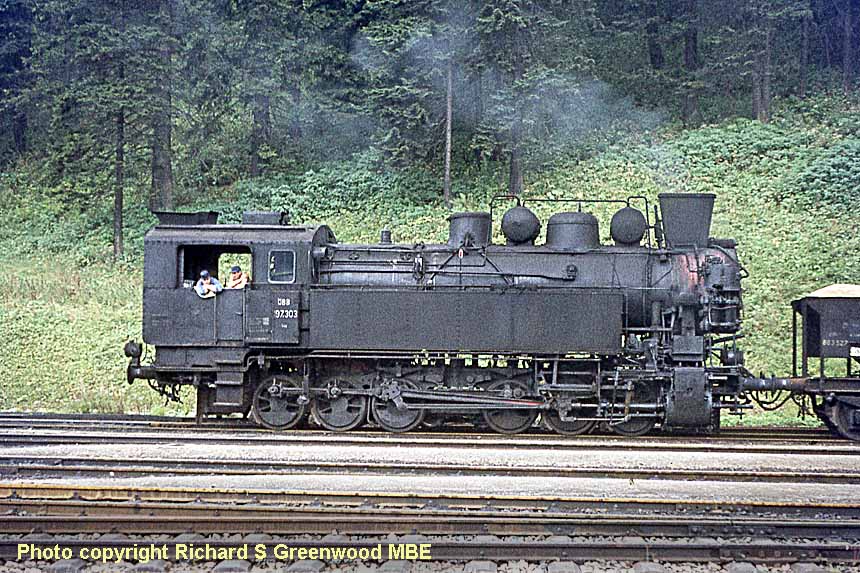

(Above-Below) One of the twelve coupled locos is descending the incline with a loaded train. (Below) The same train on the steepest part of the gradient. Check the perpendicular - it's correct as can be seen from the buildings.


(Above-Below) On this train of empties climbing the gradient the larger locomotive leads and one of the smaller 0-6-2Ts is at the rear. (Below) Back at Vordenberg, although the line was electrified for the ore trains bound for the Donauwitz steel works at Trofaiach, the branch passenger trains from Leoben were worked by the ubiquitous class 52s, in this case Giesl fitted 52 2325.


(Above-Below) The same train. There is a sense of brooding from the encircling mountains as clouds build up for the regular summer afternoon thunderstorm. (Below) The boundary between Austria and Yugoslavia gave an opportunity to take a photograph of a Yugoslav (JZ) steam locomotive number 25 20 at a border station. It can be seen that the influences of the Austro Hungarian school of locomotive design were still to be seen in Yugoslavia which had been a part of that empire.


(Above-Below) Unfortunately no colour shots exist for the next three images. The Austrian 86 class of heavy 2-8-2T was virtually identical to the German class 86. Exiting from a tunnel at Hieflau in June 1967 is 86 476 piloting a class 52 on an ore train which has come from Eisenerz. (Below) A lightweight 2-8-2T for branch line work was the 93 class; Here we see 93 411 at Perg.


(Above) Any small four wheel locomotive is a 'Pug'. And a diesel is a 'Fug'. And German for a train is 'Zug'. So this trains of one four wheeled coach seen at Perg could be described as a 'Fug Pug Zug'.
Still more to come? Richard's railway holidays abroad will continue with a handful of colour shots of steam in Portugal, Germany, Poland, USA and Turkey...
WATCH THIS SPACE!
CLICK HERE TO VISIT RICHARD'S FIRST 'RAIL CAMERAMAN' PAGE...
CLICK HERE TO VISIT RICHARD'S 'RAILWAY ROUNDABOUT 2' PAGE
Before the advent of cheap flights to the 'Costa del Anywhere' the Isle of Man was about as far abroad as hundreds of thousands of holidaymakers from Lancashire, Yorkshire and Clydeside ventured. They sailed to Douglas from Liverpool, Fleetwood and Ardrossan on the regular sailings of the Isle of Man Steam Packet Company Ltd (IOMSP) which operated a fleet of fast, attractive 'mini-liners' whose house colours on the funnels were the same as Cunard. Other ports served during the main holiday seasons included Dublin, Belfast, Heysham and Llandudno. Sailings to and from Ardrossan also called at Ramsey Pier in the north of the Island; indeed everyone went by sea, certainly we regularly took day trips during the 1960s and early 1970s; this is a view (below) of the foredeck of the IOMSP's 'Snaefell' approaching Douglas.


(Above) Another view of the harbour approach: four boats are tied up alongside the Victoria Pier; nearest the camera is the 'Lady of Man' and on the opposite side of the pier is the 'Ben-my-Chree'. These were the
 largest two boats in the fleet and therefore both were berthed at the seaward end of the Victoria Pier. The other two boats tied up at the Victoria Pier are not identifiable.To the left is the King Edward Pier with a fifth unidentified boat alongside and the harbourmaster's office visible at the end. Out of sight to the left is the Battery Pier giving protection to the harbour from the open sea. Fishing and freight boats used the Inner Harbour by sailing along the channel to the left of the King Edward Pier. The terrace of tall hotels and boarding houses on the extreme right of the photograph is the start of the Loch Promenade. Please note this is a super-wide image and you will need to 'click-on' twice (not double-click) to see the full-size image.
largest two boats in the fleet and therefore both were berthed at the seaward end of the Victoria Pier. The other two boats tied up at the Victoria Pier are not identifiable.To the left is the King Edward Pier with a fifth unidentified boat alongside and the harbourmaster's office visible at the end. Out of sight to the left is the Battery Pier giving protection to the harbour from the open sea. Fishing and freight boats used the Inner Harbour by sailing along the channel to the left of the King Edward Pier. The terrace of tall hotels and boarding houses on the extreme right of the photograph is the start of the Loch Promenade. Please note this is a super-wide image and you will need to 'click-on' twice (not double-click) to see the full-size image. (Below) A fine view of Douglas Harbour's Victoria Terminal and distinctive clock tower circa 1930s courtesy Barry Hilton's family album; the busy scene shows IOMSP boats tied up alongside the pier, several horse-drawn tram vehicles and the glass roofed arcade on the right. Since the arrival of today's vehicle roll-on roll-off ferries the mass foot-passenger traffic seen in this picture is now very much a thing of the past.


(Above-Below) Douglas Harbour is well sheltered from the westerlies but when gales blow up from the east the harbour is exposed. the IOMSP boats occasionally had to head to the west of the Island - Peel or Port Erin when strong winds came from the east. This map section of the Isle of Man circa-1946 shows some of the shipping routes from mainland Britain; the map has been scanned, cleaned and digitised from an old, out of copyright original by The New Society for the Diffusion of Knowledge (NSDK)...the full map can be found on the Society's excellent website HERE. (Below) After disembarking at the King Edward Pier we see the bow of 'Snaefell' on the right and three other IOMSP boats at the Victoria pier; the tall funnel belongs to the famous 'Lady of Mann' of 1930, the flagship of the fleet.

 The Isle of Man measures 35 miles by 15 miles, its magnificent scenery varying from flat plains to deep river valleys (Glens) and rolling hills, the highest of which, Snaefell - the snow mountain - rises to just over 2,000 feet high. The influx of holidaymakers concentrated on the capital, Douglas on the eastern seaboard. The main entertainment venue in the resort was the Villa Marina and most years the star attraction was Joe Loss and his Band.
The Isle of Man measures 35 miles by 15 miles, its magnificent scenery varying from flat plains to deep river valleys (Glens) and rolling hills, the highest of which, Snaefell - the snow mountain - rises to just over 2,000 feet high. The influx of holidaymakers concentrated on the capital, Douglas on the eastern seaboard. The main entertainment venue in the resort was the Villa Marina and most years the star attraction was Joe Loss and his Band.Who, if anyone, now remembers Cunningham's Camp for Young Men at Onchan?
Perhaps a few more can recollect the requisitioned Hotels along the seafront at Douglas used for the internment of enemy aliens between 1939 and 1945. And what about having to don lifejackets on departing from Liverpool as U-Boats had been busy laying mines in the Mersey estuary?
Bacon, butter and other dairy produce was not rationed in the Isle of Man, at least in the first years of the war, so returning holidaymakers stocked their cases full of rationed foodstuffs, only in many instances they were confiscated by HM Customs on arriving at Liverpool. After the blitz in December 1940, Liverpool Docks were devastated and conditions in the Mersey became so dangerous that the regular Isle of Man sailings were transferred to Fleetwood from the start of 1941 until 1946. The Isle of Man steamer 'Victoria' did hit a mine in the Mersey estuary but fortunately was not seriously damaged. Victoria had been acquired second hand, having originally been built for the South Eastern and Chatham Railway for cross-Channel work.
 The Island was and still is especially famous among the motorcycling fraternity for the world famous TT road races, and the lesser important GP week.I wonder if the 'Manx Norton' motorcycle is still displayed in the Crosby Hotel?
The Island was and still is especially famous among the motorcycling fraternity for the world famous TT road races, and the lesser important GP week.I wonder if the 'Manx Norton' motorcycle is still displayed in the Crosby Hotel? When on family holidays in Douglas during TT week, we might stay in the same establishment as some of the TT riders; this was a chance to politely request one of the race numberplates carried on the bikes; the Senior Race riders had a red background and the Junior Race riders blue. The race had a staggered start, with the faster riders in the practice runs going off first to avoid the slower bikes; one year my sister and I bagged a couple of souvenirs: a red numberplate number 16 and a blue junior numberplate about 59. And of course, on returning home we rode around on our pedal bikes for some time with the handlebars adorned by them.
A somewhat tongue-in-cheek impression of the TT races can be obtained from the 1935 George Formby comedy film, 'No Limit' (left).
Night Owls listening to the BBC's midnight Shipping Weather Reports will be familiar with the term 'Ronaldsway' and how visibility there was usually the best in all the UK reports; the weather reports had earlier come from the RAF base at Jurby in the north of the Island until it closed.
Everywhere you could buy Manx kippers and even have them mailed to the folks back home. There is a native breed of sheep and, of course, the famous Manx cats with no tails. Nowadays financial services are the biggest earner, taxes are low and the Island is governed by the 'House of Keys' which claims to be the oldest uninterrupted parliament in Europe. The Isle of Man is not part of the United Kingdom; nor does it come under the rule of the EU, luckily for them! The island's official status is that of a self governing Crown Dependency therefore its old fashioned practices have not all been banished in the mistaken pursuit of progress.
 Listeners to BBC's 'News from the North' frequently heard how day trippers bound for Douglas on the coal burning 'Viking' spent the day on a sandbank off Fleetwood. 'Viking' spent 49 years in service with the IOMSP fleet and on war service; indeed the IOMSP's ships played a big part in the Dunkirk evacuation.
Listeners to BBC's 'News from the North' frequently heard how day trippers bound for Douglas on the coal burning 'Viking' spent the day on a sandbank off Fleetwood. 'Viking' spent 49 years in service with the IOMSP fleet and on war service; indeed the IOMSP's ships played a big part in the Dunkirk evacuation.Into the nineteenth century the Island belonged to the Lord Derby and the name 'Derby' is perpetuated in Derby Castle at Douglas, also by one of the long-withdrawn 2-4-0T steam locomotives No2 'Derby' and the famous horse race latterly run at Epsom which started as a race at Derbyhaven near Castletown in the south of the island.
There are so many attractions for the historically minded, from ancient crosses and burial grounds to the famous 'Lady Isabella' waterwheel (right) once used to pump water out of the old lead mines. Much of the public transport system has a Victorian flavour; the steam railway, the Manx Electric Railway and the mountain line to the summit of Snaefell are all operated by the island's Department of Tourism & Leisure. Horse trams still ply the front at Douglas in summer - indicated 'E' on the map below, while the Manx Electric Railway 'D' runs from Derby Castle at Douglas to Ramsey, connecting with the electrified Snaefell Mountain Railway at Laxey. The cable car system to Upper Douglas is not even a memory now but a part of the Isle of Man Railway still continues in operation.
In 1873 the first railway opened between Douglas and Peel (indicated 'B' on the map below); next a more ambitious line was built from Douglas to Port Erin 'F'. An independent concern, the Manx Northern Railway, built a line from St John's on the Peel line round the west coast to Ramsey 'A', along with another line to the lead mines at Foxdale. The MNR was soon taken over by the IMR.


(Above-Below) The first section of the 3ft-gauge Manx Electric Railway was opened between Douglas and Groudle in September 1893. The line was extended to Laxey in July the following year, and then on to Ramsey (Ballure) four years later. The final leg of the 500vDC route was completed to Ramsey (Plaza) in July 1899. (Above) Back in the day when cars had vinyl roofs, tramcar No 26 and trailer was photographed at
 Derby Castle station at the northern end of Douglas promenade. This vehicle was one of four open cars Nos 24-27 purchased from GF Milnes & Co in 1898, and subsequently dubbed 'paddleboxes' due to their unusual footboards being built to accommodate the protruding bogies. Opened in 1893 the MER's Derby Castle terminus was so called because the area at that time housed a vast entertainment complex of that name. In the background can be seen the now-demolished Aquadrome Swimming Pool & Sauna which was part of the Summerland indoor leisure complex; the three-and-a-half acre building was clad in part with a new Perspex-like material, which proved to be disastrous when the complex was engulfed in flames on the evening of 2nd August 1973. Within minutes the whole site was ablaze and fifty people lost their lives. (Below) Manx Electric Railway Car No 6 is reversing at Groudle Glen. This vehicle was among the second batch of six cars Nos 4-9 delivered to the railway for its opening to Laxey in 1894. They were referred to as 'tunnel cars' because their seating was originally fitted parallel to the sides with just one large passenger saloon as opposed to the more traditional reversible seating common in tramcar layout.
Derby Castle station at the northern end of Douglas promenade. This vehicle was one of four open cars Nos 24-27 purchased from GF Milnes & Co in 1898, and subsequently dubbed 'paddleboxes' due to their unusual footboards being built to accommodate the protruding bogies. Opened in 1893 the MER's Derby Castle terminus was so called because the area at that time housed a vast entertainment complex of that name. In the background can be seen the now-demolished Aquadrome Swimming Pool & Sauna which was part of the Summerland indoor leisure complex; the three-and-a-half acre building was clad in part with a new Perspex-like material, which proved to be disastrous when the complex was engulfed in flames on the evening of 2nd August 1973. Within minutes the whole site was ablaze and fifty people lost their lives. (Below) Manx Electric Railway Car No 6 is reversing at Groudle Glen. This vehicle was among the second batch of six cars Nos 4-9 delivered to the railway for its opening to Laxey in 1894. They were referred to as 'tunnel cars' because their seating was originally fitted parallel to the sides with just one large passenger saloon as opposed to the more traditional reversible seating common in tramcar layout. 

(Above) Opened on August 21 1895, the 3½ft gauge Snaefell Mountain Tramway was equipped with a Fell centre rail (for braking purposes) and operated between Laxey and Snaefell Summit. The line was incorporated into the Isle of Man Tramways & Electric Power Co Ltd before the Manx Electric Railway Co Ltd took over the running of the line in August 1902; a little over fifty years later the company's operation was acquired by the Manx Government in 1956. Today the line comes under the auspices of the island's Department of Tourism & Leisure.
(Below) the TT course crosses the line of the Snaefell Mountain Railway at 'Bungalow' (see map below) and during the races the SMR runs shuttles to both sides of the road with a scaffolding footbridge across the road itself for its passengers


(Above) Rail Cameraman, Barry Hilton's family interest in the Isle of Man began in the early 1900s. His grandfather worked for the Bradbury's Motorcycle Company in Oldham, Lancashire prior to its closure in 1924. Being a keen motorcycle enthusiast he regularly went to the TT Races, and at the outbreak of WW1 (he was too young to enlist) he became a dispatch rider, until he fell off his motorcycle and broke his arm! Barry's father recalls taking regular trips to the IOM as a boy in the 1930s; this is a cheeky shot of him posing precariously on the front of an ex-Manx Motors Daimler single decker, Fleet No 81 - ADC 416A chassis, Bell body - registration No MN5511 at Laxey. The vehicle was withdrawn in 1949.
(Below) Fast-forward 70-odd years to April 2011, and Barry decided to take a nostalgic trip back to the island to celebrate his dad's 87th birthday. After catching the ferry from Heysham, they spent a week touring by bus, tram and train, revisiting the old tourist sites at Port Erin, Ramsey, Peel, Laxey and a tram ride to the top of Snaefell. These colour shots are a record of their trip on the Snaefell Mountain Railway. His dad thoroughly enjoyed his IOM trip although he said the greatest thing he missed were the old Steam Packet Boats!



ISLE OF MAN STEAM
 Eighteen steam locomotives have worked the three foot gauge system, fifteen of them being 2-4-0Ts built by Beyer Peacock of Manchester, fourteen built for the IMR and one for the MNR. These IMR locomotives came in various sizes. The MNR originally had two small 2-4-0Ts built by Sharp Stewart also of Manchester. These proved too small so the Manx Northern Railway acquired its own 'Peacock'. After the merger this became IMR No 14 'Thornhill'. The odd man out was a 0-6-0T No 15 'Caledonia', built by Dubs of Glasgow for handling the ore traffic on the steeply graded Foxdale line.
Eighteen steam locomotives have worked the three foot gauge system, fifteen of them being 2-4-0Ts built by Beyer Peacock of Manchester, fourteen built for the IMR and one for the MNR. These IMR locomotives came in various sizes. The MNR originally had two small 2-4-0Ts built by Sharp Stewart also of Manchester. These proved too small so the Manx Northern Railway acquired its own 'Peacock'. After the merger this became IMR No 14 'Thornhill'. The odd man out was a 0-6-0T No 15 'Caledonia', built by Dubs of Glasgow for handling the ore traffic on the steeply graded Foxdale line. This selection of photographs contains pictures from 1959, 1960 and 1964. We did not have a car back then and had to rely on public transport. Douglas station was the headquarters of the Railway. This is the view (left) from a train approaching Douglas station from the Port Erin line.
(Below) Freight traffic was often carried in wagons attached to passenger trains. This shot shows ex-MNR No 14 'Thornhill', detaching the two open wagons from a train which had just arrived from Port Erin. No 14 is a former Manx Northern Railway locomotive.


(Above-Below) No 1 'Sutherland' built 1873 is acting as station pilot, shunting wagons. No 1 retains the small boiler, Salter Safety valves on top of the dome and small sidetanks of the original engines. Note also the old-fashioned sloping front to the smokebox (Below) The other view of goods being shunted at Douglas shows No 5 'Mona' which has been rebuilt with a larger, higher pressure boiler and larger sidetanks. It was as a somehwat bored small boy in 1948 one wet Sunday afternoon in Ramsey I found that it was possible to move one of the MER box vans merely by pushing it!
At this juncture I'd like to thank John Kinley for dropping a line. The need for accurate details in captions is important; this is especially the case when captioning old photos from fifty-odd years ago… it seems such a long time ago!
John kindly writes...
'I just wanted to say how much I enjoyed the IMR pictures; absolutely brilliant! Thanks so much for sharing. Apologies for being a pedant but I think you may have got a couple of the locos wrong in the pictures…the IMR locos do all look very similar at first glance but they all have their own little quirks, such as domes/ safety valves/ chimneys and patches on the tanks, which, once you know them, enables you to tell the difference, even if you can't see the number!
For example, the picture (above) of No 1 'Sutherland' shunting is almost certainly No 14 'Thornhill'. Number One had lost her Salter valves by the early 1960s and has a pop valve in the dome and one on the first ring of the boiler barrel known as one of the two 'Bradshaw' boilers (it also still had its chimney numeral). The second picture (below) of No 5 'Mona' shunting is almost certainly No 6 'Peveril'. No 5 had lost her copper capped chimney in about 1946 when it was re-boilered and the lack of cab side builder's plate means it isn't No 13 'Kissack'. Finally, the 'tail' loco (third photo below*) is No 10 'GH Wood' (note the cast chimney/closed dome/ curved patch on the front of the tanks - another photo of No 10 at St John's appears further down the page). Number 3 'Pender' still has a small boiler at her current home in the Science Museum in Manchester (the second Bradshaw boiler as described above).
Hope this info helps and thanks again for sharing them
Best Wishes, John Kinley (Isle of Man).
PS Love the Northern Ireland pics as well!


(Above-Below) Trains from Peel and Ramsey were often combined at St John's and run 'top and tail' in modern parlance. Arriving at the head of a combined train at Douglas is No 12 Hutchinson. (Below*) Following arrival and smart work uncoupling, the 'tail' loco No 3 'Pender' sets off for the shed. Originally 'Pender' was a small boiler engine but it was later rebuilt with a larger boiler...the loco in this picture has now been identified as No 10 'GH Wood'.


(Above-Below) The third shot of a sequence of four - all taken within minutes of one another - shows No 12 heading off along the centre release road. Note the Royal Mail van visible on the platform. (Below) The final shot from the platform shows No 12 on one of the shed roads; baskets were used for hand coaling.


(Above-Below) No 3 'Pender' gets into the act again running along the release road after arrival. (Below) No 12 'Hutchinson' and 8 'Fenella' are seen waiting on the headshunt which leads to the shed. No 8 has one of the small boilers and small side tanks of the first locomotives, however after acquiring a new boiler the increased boiler pressure made it a much better performer.


(Above-Below) The same two locos are seen after coming off the shed headshunt. (Below) St John's was the junction where the Peel and Ramsey lines split. Each route through the station had a loop so there were four platform faces. A general view of the station from the west end shows the Ramsey train on the left and the Peel train on the right.


(Above-Below) No 10 'G H Wood' is at the head of a Peel train in the platform at St John's. (Below) This map section of the Isle of Man circa-1946 has been scanned, cleaned and digitised from an old, out of copyright original by The New Society for the Diffusion of Knowledge (NSDK)...the full map can be found on the Society's excellent website HERE.


(Above-Below) The last locomotive built for the Railway entered service in 1926 and was noticeably larger than the rest with a more conventional cab. This is No 16 'Mannin' ready to depart with a short train to Peel. By this date the pressure of its original boiler had been reduced and it was employed on light duties. (Below) No 13 'Kissack' has a Ramsey train at St John's ready to depart.


(Above-Below) On another date No 13 'Kissack' arrives from Ramsey; note the saloon coaches in the sidings to the right. After I took the photograph No 13 drew ahead, set back and coupled onto the saloons before setting out for Douglas (below). Locomotives always worked chimney first from Douglas.


(Above-Below) Some idea of the idyllic country setting of St John's station in typical Isle of Man scenery can be gathered from this shot of No 14 'Thornhill', appropriately an ex-Manx Northern loco, waiting at St John's to take over a Ramsey portion in 1964. For those more interested in things mechanical than scenic, below is a close up of the locomotive.


(Above-Below) This is another occasion at St John's in 1960; a snatched shot looking back from a Peel train departing St John's with No 14 'Thornhill' not far behind with the Ramsey portion. The Peel and Ramsey lines separated just beyond the level crossing at the west end of the platforms. (Below) A Peel train sets out with an assortment of old coaches...the Ramsey line parallels it on the left.


(Above-Below) No 6 'Peveril' with a one coach train for Peel is seen a short distance further west. (Below) No 8 'Fenella' climbs away above the Peel line with the main train bound for Ramsey.


(Above-Below) Now a single shot at Peel of No 6 'Peveril' as it runs round. On the skyline can be seen Peel Castle which is situated on St Patrick's Isle with a causeway to the mainland. The maroon coaches in the background were not normally used on the ordinary trains. (Below) Unfortunately I have no colour photographs taken on the Ramsey line so we turn to the Port Erin Line, now in 2014, the only line still operating. Descending the steep gradient into Douglas one morning with three coaches and two vans is an unidentified locomotive.


(Above-Below) An idea of the countryside can be gained from this photograph taken from the train near Santon. Ballasalla was a splendid photogenic spot for afternoon down trains. (Below) No 10 'G H Wood' enters the station with a train from Douglas.


(Above-Below) A few years earlier No 12 'Hutchinson' passes the water tower and approaches the level crossing at Ballasalla on 13 June 1960. (Below) No 12 'Hutchinson' is seen once again entering the station at Port St Mary. In 1960 we stayed at the Balqueen Hydro on the Promenade at Port St Mary…long since gone.


(Above-Below) This loco is seen yet again at Port Erin station about to set out for Douglas. (Below) Another Douglas departure prepares to depart from the same station behind No 13 'Kissack'. I recall the Isle of Man Railway using some kind of chemical weedkiller around their stations which had a somewhat unpleasant, lingering smell.


(Above-Below) As at Peel and Ramsey there was a small engine shed at Port Erin and No 5 'Mona' is being put away for the night. One of the most important colony of choughs (a species of crow) in Britain is to be found along the cliffs north of Port Erin. South of the island lies a much smaller island, the Calf of Man, which is a bird sanctuary and south of that an important lighthouse on Chicken Rock. We finish with a scenic shot (below) taken from Beach Road in June 1960; it shows a train from Port Erin to Douglas shortly after leaving Port St Mary...just visible on the skyline is Bradda Head which overlooks the bay at Port Erin.


(Above-Below) Time to return home; tied up at the Pier at Douglas harbour are a couple of IOMSP boats plus a third tied up at Battery Pier. (Below) An Isle of Man passenger steamer heads up the Mersey past Clarence Dock power station. Efforts to preserve the last of this magnificent fleet, 'Manxman' built in 1955, failed and already semi-derelict it was scrapped in 2010 at Sunderland. Please note this is a super-wide image and you will need to 'click-on' twice (not double-click) to see the full-size image.


(Above-Below) A spinoff from the Isle of Man holiday was the opportunity to see some of the bigger ships in the Mersey, such as the Cunard liner, 'Sylvania' - another super-wide image - plus a close-up of the tugboat (below) and finally a shot of the Canadian Pacific 'Empress of Britain'.


Isle of Man Holiday Tickets
The Booking Clerk at Smithy Bridge was proud of his 'LMSR Foreign and Saloon' tickets - 3rd class rail but Saloon on the boat. Strictly he shouldn't have issued them for a journey to Douglas but decided to anyway. The tickets had a little paper insert with adverts on (below).

(Below Left) We resorted to a certain amount of subterfuge to avoid the halves being collected at the appropriate time. As our party of four passed through the barrier at Liverpool Exchange I remember the ticket collector remarking - 'There's a lot of very old tickets about today!' The ticket is dated 10 June 1960 but we travelled a couple of days afterwards. The fare is handwritten at 71/6d. That's seventy one shillings and sixpence or £3.58 decimal...

On the reverse side of the ticket (above right) are the terms and conditions which state - 'The Companies or Owners on whose Railways, Coaches or Vessels this ticket is available are not liable for any occurrence however arising off their own Railways Coaches or Vessels and their liability on their own Railways Coaches is limited by the conditions contained in their respective Timetables Bills & Notices which form part of the terms of this Contract. Included in the Steamship Owners' conditions is a provision that they are not liable for loss of life or loss or injury to Passengers or their luggage from whatever cause arising.'


NORTHERN IRELAND STEAM
My brother and I spent a couple of days in Northern Ireland from 28 June to 1 July in 1964, before going on to the Isle of Man for a few days. Northern Ireland Railways were in a parlous state. The main railways had firstly been the Great Northern Railway of Ireland several of whose lines including the main Belfast to Dublin route crossed the border, and secondly the Northern Counties Committee comprising the Belfast and Northern Counties Railway (once owned by the LMS) and other smaller Companies.
When the Great Northern Railway of Ireland - GNR(I) - went out of business in 1951 their lines both north and south were taken over and operated by a joint governmental Great Northern Railway Board until 1958 when the Board was dissolved and the assets were split. Eighty three locomotives including two Class S 4-4-0s went to the Ulster Transport Authority which had been formed in 1949 on the nationalisation of the NCC. The GNR(I)'s interest in the south became part of Coras Iompair Eireann (CIE). But the CIE ceased to use steam in 1963 and their three class S 4-4-0s were then transferred to the UTA.
Many lines had been closed and more were to follow but in the summer of 1964 in the north there were still a fair number of steam locomotives running. Passenger work was largely performed by the ex-GNR(I) class S 4-4-0s. In addition the ex-NCC class W 2-6-0s designed at Derby and based on the highly successful Fowler parallel boiler 2-6-4Ts of the LMSR and the class WT, a 2-6-4T version of the W class.
We sailed overnight from Heysham to Belfast and at Great Victoria Street station we found the usual Sunday excursion to Dublin in the hands of one of the fifteen ex-NCC class W 2-6-0s No 97 'Earl of Ulster'.

(Above) Ex NCC 97 'Earl of Ulster' waits at Great Victoria Street station Belfast. (Below) Somehow we'd heard that on 28 June there would be several excursion trains to Warrenpoint, the end of a freight only branch from Newry. So, we left the Dublin train there and boarded an excursion to Warrenpoint hauled by 174 'Carrantuohill' one of the magnificent ex-GNR(I) Class S 4-4-0s, a product of Beyer Peacock of Manchester in 1912. One of the class is preserved as a runner on the Irish main lines...No 171 'SlieveGullion'.


(Above) The whole class of five locos were named after Irish mountains. In 1964 these engines were still running in GNR(I) blue livery although their cleanliness left much to be desired. Nonetheless the blue could still be seen when the sun was shining and the letters 'G N' could be read on the tenders. We see No 174 at the platform at Portadown. (Below) The route was via Newry and at Newry South the train was stopped at the signal guarding a level crossing.


(Above) The S class locomotives only just fitted on the turntable at Warrenpoint with barely an inch to spare. Then it was a case of manhandling them round. (Below) No 174 is seen at the head of the empty stock at the platform.


(Above) At least one 0-6-0, UG No 49, was used on one of the Warrenpoint excursions. (Below) A second Class S 4-4-0 No 170 also brought in another excursion.


(Above) No 170 also successfully accomplished the visit to the turntable. (Below) Both Class S 4-4-0s in the station yard awaiting their return journeys.


(Above) At Warrenpoint we met a friend on holiday with his parents and he had his car with him. This enabled us to leave the station environs at Warrenpoint for other viewpoints. We didn't have long to wait as No 174 was seen passing Narrow Water Castle en route back to Newry. (Below) We managed to overtake it in time to get another shot of it at Newry Monaghan Street.


(Above) By now the sun was shining so a visit to Portadown shed was called for. The shed was a rather modern looking concrete three-quarter roundhouse. Seen in the stalls are a couple of Class Ws No 91 'The Bush' and 99 'King George VI', plus a WT 2-6-4T No 57 and an SG3 0-6-0 goods engine No 33. (Below) Other locomotives in light steam ready for the Monday morning traffic were a U class 4-4-0 No 66 named 'Meath' built as late as 1949 by Beyer Peacock, WT No 8, and an ex-GNR(I) class SG2 0-6-0 No 43. Apart from the W and WT class all the locomotives were ex GNR(I).




(Above) There followed a Monday with little railway interest (as the Giants Causeway Electric Tramway had long been abandoned) but inside the apparently derelict GNR(I) loco shed at Londonderry we found class W No 99 'King Geoge VI' which was in the Portadown roundhouse the day before. It had obviously arrived on a freight. (Below) A second loco, SG3 0-6-0, that we had seen the previous day at Portadown, was engaged on shunting the yard. The GNR(I) passenger service to Londonderry from Portadown via Omagh and Strabane had already been withdrawn.


Pics 018 019 (Above) On Tuesday a journey by bus to Belfast and a hurried walk to Great Victoria Street saw us making the Dublin train by the skin of our teeth! We scrambled aboard the carriage accompanied by shouts of - 'Hold the train, two passengers for Portadown...' There couldn't be many places in 1964 where you could find 4-4-0s at work and the station pilot at Portadown was U class 4-4-0 No 68 'Down'. (Below) When the midday Belfast to Dublin train rolled in it was in charge of Class WT No 53 with a steam loco tender attached. The idea was to enable the WTs to run the full 108 mile distance between Belfast and Dublin without having to take water en route. Although the CIE was fully dieselised, steam locomotives from the north continued on the Belfast trains for some time yet. But the experiment was short lived and not considered a success.


(Above) A long northbound freight left Portadown behind a Class WT 2-6-4T No 8. (Below) As we made our way by train northwards towards Belfast we encountered the same freight at Lisburn.


(Above-Below) Now two southbound passenger trains at Lisburn, WT No 54 on a train of CIE coaches with a train for Dublin and another WT No 1 (below) on a stopping train.


(Above) One of our friends from Sunday was this ex-CIE Class S No 170 'Errigal', seen here at Dunmurry on a southbound passenger train. (Below) Inside the shed at Adelaide is one of the large three cylinder Class VS 4-4-0s of the GNR(I) No 209 'Lagan', unfortunately out of steam.


(Above-Below) Other scenes taken on the shed that day include these evocative shots of working steam locomotives in the traditional setting of a steam shed now long since gone but fondly remembered.


(Above) Another class S is seen in this three-quarter rear view as it departs from Adelaide station towards Portadown. (Below) A distant view of the return daily excursion train from Dublin with an unidentified class W in charge.


(Above) Last shot of the evening of 30 June 1964 captures a Class S returning light engine to Adelaide shed. (Below) The following morning there was a procession of four steam hauled commuter passenger trains to and from Belfast, beginning with a tender-first Class S…


(Above-Below) The Class S was followed by Class UG 0-6-0 No 47 (above) and another old friend WT No 1 (below)…


035-036 (Above) Unsurprisingly the last train was hauled by yet another Class S; these 4-4-0s were so frequently used it was difficult to believe that there were only five of them. (Below) The only locomotive which was neither ex-GNR(I) nor ex-NCC, was 0-6-4T 'Lough Melvin' of the former Sligo, Leitrim and Northern Counties Railway, absorbed into UTA in 1949. This was yet another Beyer Peacock product having been built in 1949. It was shunting at the UTA works at York Road Belfast.

(Below) We end our visit with a nostalgic shot of 1960s cars parked in the Works Car Park as 'Lough Melvin' continues its shunting duties. Then it was off to the Airport for the short hop to the Isle of Man in a Vickers Viscount of Cambrian Airways.

KENYA 1978
Following the end of BR steam in 1968 not many railway enthusiasts visited Kenya, even though a good number of steam locomotives were still working even as late as June 1978. During our visit several steam classes were operating the main line from the port of Mombasa on the Indian Ocean to Nairobi and to Kampala in Uganda. Steam action could also be found on two other lines from Nakuru to Kisumu and onwards to Butere plus the line from Voi to Taveta. However at the time of our visit the border between Kenya and Tanzania was closed, therefore the line from Voi to Taveta and onwards across the border to Moshi in Tanzania saw very little traffic.
Conceived in 1896, construction work of the line from Mombasa to Uganda commenced in a somewhat half-hearted fashion since the company was using second hand equipment from India. This explains why the gauge of 1 metre was adopted rather than the 'Cape' gauge of 3 feet 6 inches; the latter gauge being the proposed standard system all the way from the Cape of Good Hope to Cairo. During construction the railway engineers encountered many setbacks, including flooding, sickness and the need to negotiate the steep escarpment into the Rift Valley - not to mention platelayers being devoured by lions - but the line eventually reached Kisumu in 1901. From Kisumu the connection to Uganda was by boat on Lake Victoria. Kampala was not reached by rail until 1931. The history of building the line and much else can be found in the voluminous 559-page book 'The Lunatic Express' by American author, Charles Miller published 1971...highly recommended.
From Mombasa the line traversed the coastal tropical area as far as Nairobi's scrubby desert; the company established its main workshop at Nairobi on account of a plentiful supply of fresh water, beyond which the line traversed the lush agricultural area. The railway was originally operated by the Uganda Railway, then the Kenya Uganda Railway, next the East African Harbours Railway and finally Kenya Railway. The distance from Mombasa to Nairobi is 275 miles and the altitude at Nairobi is 5,890 feet above sea level. In the twenty six years since our visit the population of Nairobi has increased six fold to over three million.
Beyer-Garratt articulated steam locomotives were introduced on the line in 1930, but by 1978 only two classes survived: the 60 class with a wheel arrangement of 4-8-2+2-8-4, built by Beyer Peacock of Manchester in 1953-1954; these locos weighed 152 tons with a tractive effort of 43,520lb. But the class was overshadowed by yet another Beyer-Peacock-built Beyer-Garratt - the 59 class - of the same wheel arrangement, but weighing in at no less than 251 tons. With a tractive effort of 83,350lb the 59 class was the most powerful steam locomotives ever built for such a narrow gauge; they were capable of hauling bulk freight trains consisting of twelve 100 ton wagons on the Mombasa-Nairobi main line which had gradients as steep as 1 in 60 in some places.
By 1978 all steam locomotives used oil fuel and the larger locomotives were fitted with Giesl exhaust ejectors which increased their haulage capacity due to the reduction in back pressure on the pistons. Apart from the class 59 and 60 Garratts, four other classes were still in use; these included the class 29 2-8-2 tender locomotives built by North British at Glasgow in 1951-1952, the class 31 2-8-4 tender locomotives built by Vulcan at Newton-le-Willows, and a handful of 4-8-4T shunting locos built by Bagnall of Stafford in 1950. However, the class described as 'the most successful steam locos ever built for East Africa', namely the class 24 4-8-0 tender engines, were regularly seen during our visit. Built between 1923 and 1930 by Vulcan Foundry and Nasmyth Wilson of Patricroft, the locos were primarily used on lightly laid branch lines.

(Above) A view of part of the running shed at Nairobi, albeit in a somewhat dilapidated state with one of the class 13 4-8-4Ts prominent alongside an unidentified 60 class. At this time Nairobi loco works was converting boilers from the withdrawn 60 class locos for use in sugar refineries. (Below) Alongside Nairobi shed, we see one of the oldest class of locos, No 2814 just ex-works on its acceptance trials. The gentleman in the turban was at that time the Chief Locomotive Inspector. The pristine paintwork has been burnt at two places where the cab roof joins the cab side. No doubt the Chief Loco Inspector had requested some modifications.


(Above) No 2406 of the same class is seen inside the shed building at Voi. (Below) The following day No 2406 was in charge of a ballast train on the branch towards Taveta. We were very fortunate to see a train on this line which ran through the grounds of the Holiday Lodge where we spent the night disturbed throughout by the croaking of frogs! Three further photographs give an idea of the type of countryside the branch ran through.





(Above) In Voi shed yard one of the two smaller Garratts, class 60 No 6023 was on shed. (Below) No 6013 of the same class, is partially hidden in the shed where 2-8-4 No 3120 is about to emerge.


(Above) 3120 is now in the shed yard and being lit up...clearly visible is a cloud of blue haze of smoke and fumes, as is so often the case when lighting up an oil fired engine! (Below) The loco machine shop at Voi was open at the sides, protected only by a wire mesh; we noted three machine tools in use, all manufactured by British firms based in Hebden Bridge, Halifax and Keighley. The pilot on this occasion was another class 13 4-8-4T No 1317.


(Above) Two super-wide images, starting with this head on shot of No 5915 at Voi which accentuates the size of the huge 59 class machines compared to the track gauge. (Below) Voi was a watering and fuelling point for the mainline trains. In this shot a 59 class is taking water from the water crane at the front and oil fuel into the fuel tank where the shedman is controlling the valve.


(Above) There followed several other shots of the 59 class at Voi: the first one showing No 5901 restarting its train of oil tank wagons. (Below) Both front and rear views of another 59 class taking fuel, while the final shot in the sequence is an interloper...an English Electric diesel draws up alongside.





(Above) In the coastal tropical strip near Mackinnon Road, a block train of 1200 tons is in charge of the inevitable 59. (Below) Moving up to the desert section, another view of a 59 at one of the passing loop stations. One of these stations is named 'Simba' - Swahili for 'Lion'. At Tsavo station, just north of Voi at the entrance to the Tsavo National Park, we found a partly constructed building - possibly a Hotel or Visitor Centre. Since the work had never been finished the abandoned building had been colonised by a large troop of baboons, and the station staff warned us not to leave any items about as the baboons were master thieves.

(Below) Carrying such heavy trains with an axle loading of 25 tons per axle on the wagons and 20 tons per axle on the locomotives meant that the trackwork had to be extremely well maintained...immaculate is the words that springs to mind. This can be seen in these two photographs of a class 59 approaching the camera and then going away. The undulating nature of the line is well illustrated. Note also the smoke in the distance; this is from a train going in the opposite direction setting out from the passing loop.



(Above) I think this shot is at Nakuru - but after 35 years, the memory may be faulty. It shows one of the North British 2-8-2s No 2920 (Below) A freight hauled by a class 29 No 2917 is seen north west of Nairobi in the 'White Highlands'. It is climbing towards Limuru before descending into the Rift Valley.


(Above) We travelled second class sleeper from Nairobi to Kisumu where we found a class 31 No 3124, acting as a shunting engine marshalling the only steam worked passenger train at that time in Kenya. This was the branch train to Butere making a daily round trip. The smokebox door clearly used the same dies as those for Stanier LMS locos. On our return to Nairobi there was a Kenyan gentleman in our six berth sleeping car compartment who was met on arrival at Nairobi by the police. I found out later he was a prominent member of the Opposition Party. The breakfast menu on the train was very English (Below) Another view of 3124 at Kisumu.


(Above) Locomotive No 3126 was in charge of the train on the Butere line which crosses the Equator as it travels through a very fertile agricultural district. The passenger service was discontinued some years after our visit but recommenced in 2007. When the Kisumu stationmaster found that he had party of European visitors intending to travel, he had an old saloon brought out of the sidings and attached to train for our sole use. (Below) Another view of the Butere train at a wayside station as it takes water. The engine crew gave us all long rides on the footplate.


(Above) Another view of the locomotive in this colourful location. (Below) Just to feel at home here are two views of Leyland buses at Nairobi railway station...


AUSTRIA
I visited Austria on three occasions: 1966 on an organised trip, 1967 for a few days and in 1973 also for a few days. The following album shows the different types of steam locomotives gainfully employed on both standard and narrow gauge lines.

(Above-Below) Much of Austria is very mountainous so many narrow gauge railways were constructed after 1889. The best known is the Zillertalbahn with a gauge of 760mm. It runs from Jenbach in the Danube valley to Mayrhofen a distance of 20 miles. Today most of the traffic is worked by diesels but a handful of 'U' class 0-6-2Ts survive for special workings. (Below) Another view of the Zillertalbahn taken in 1973 near Jenbach.


(Above-Below) The first narrow gauge railway was the Steyrtalbahn, opened between 1889 and 1909. This was also built to 760mm gauge and ran from Garsten (near Steyr) to Klaus, joining two standard gauge lines through the valley of the River Steyr. In 1966 locomotive No 298 102 still had the original style of chimney. Whilst it was still open throughout in 1966 and 1967, in the following year passenger trains ceased between Klaus and Molln. (Below) Locomotive 298 53 is at the terminus of Klaus with a mixed freight and passenger train in 1967.


(Above-Below) The line closed completely between 1980 and 1982 but a section has been preserved since 1985 between Steyr and Grunburg. (Below) In both 1966 and 1967 the traffic was worked by the U class 0-6-2Ts numbered in the 298 series with 298 53 built about 1898 being the most favoured locomotive.


(Above-Below) The line ran through beautiful river valley scenery with several imposing stations. (Below) A view ahead from the footplate.


(Above-Below) By 1973 traffic was in the hands of a class 699 0-6-0T number 699 103 built in 1944. It was eventually fitted with a Giesl blastpipe and chimney, the height of the chimney being almost the same as the diameter of the boiler. Dr Giesl was an Austrian engineer who in the dying days of steam invented a blastpipe arrangement which permitted low quality coal to be burned. It was widely adopted in his home country. Other railway systems also used it. Even the oil fired Garratts in Kenya received it as the haulage capacity of the locomotives was some 10% to 15% higher due to less back pressure on the pistons. In Britain only one 9F 2-10-0 No 92250, and a 'Battle of Britain' Pacific 34064 Fighter Command were fitted. The Welsh narrow gauge line the Tal-y-Llyn Railway fitted a couple of locomotives. The privately owned 'West Country' class No 34092 City of Wells was also fitted as a means of preventing smoke drifting down obscuring the driver's vision. (Below) By 1973 passenger traffic was restricted to part of the line so 699 103 is taking freight vehicles only.


(Above) I make no excuses for including a couple more of this strangely appealing locomotive trundling over a rural level crossing amidst the beautiful Alpine scenery.


(Above) No doubt if any stray passenger had turned up they would get a ride in the coach at the rear of the train. (Below) An independent railway to the south of the country, the Graz Koflach Bahn (GKB) had built up a very varied roster of steam locomotives. Still shunting and working freights were a number of old two cylinder compound 2-8-0s of class 56 dating back to about 1914. In these views of the right-hand side of No 56 3190 shunting in the town of Koflach, the cylinder is the high pressure one and consequently of small diameter.


(Above) The locomotive then retired to the shed where we could admire the details so typical of locomotives of the old Austro Hungarian empire era (1867 to 1918). The Austrian locomotive designers, particularly Goelsdorf succeeded in producing powerful locomotives with low axle weights suited to secondary track and hilly terrain. (Below) Another of the class, number 56 3249 is working tender first on a train of logs.


(Above) Even today GKB still have a large collection of old, historic steam locomotives some of which can still be steamed. Seen in 1967, No 671 is reputed to be the oldest steamable locomotive in the world, having been built in 1860 and it was certainly steamed in 2013. (Below) Another old timer on the books is 4-4-0 415. Its design suggests it might have been older but it was built in 1897. Its last recorded steaming date is 2005.


(Above-Below) A 2-6-2T built in 1897 carrying its old Austrian Railway number of 30 39 and aesthetically a bit of a disaster, with a 'bits stuck anywhere' look about it. This view of the low pressure cylinder on the left hand side of the loco show it is noticeably larger in diameter. (Below) The GKB however had some modern power such as the class 152 2-10-0s. We see 152 309 complete with Giesl exhaust system and West German Railway (DB) 'trough' type smoke deflectors at Koflach shed.


(Above-Below) This shot demonstrates the 'bathtub' type of tender construction and a cabin in which the guard and shunters could ride. (Below) To complete the picture of this locomotive we have a shot of the front taken from inside the shed.

An aside on loco numbering. The ex-German locomotives left behind in Austria after 1945 were given a '6' prefix. So class 699 was really one of the many DR (German) class 99 - a number allocated to narrow gauge locomotives. Between 1938 and 1945 many locomotives were built in Austria to German designs and these
 were regarded as Austrian so did not receive the '6' prefix. Examples include class 50, 52 and 86. However the old Prussian G10 0-10-0 loco DR Class 57 became Austrian Class 657 (see inset right).
were regarded as Austrian so did not receive the '6' prefix. Examples include class 50, 52 and 86. However the old Prussian G10 0-10-0 loco DR Class 57 became Austrian Class 657 (see inset right). Another aside. The Class 50s were to become the workhorse of Germany's railways. Introduced in 1939, as with all modern German classes, they had bar frames. Over 3,000 were built and, as with the British MoD WD locomotives as derived from Stanier 8F 2-8-0s, in order to simplify construction by being cheaper and quicker to build, from 1942 the German class 52 was introduced with plate frames and considerable welded fabrications. Almost 8,000 were constructed in various works in Germany, Austria, Czechoslovakia and Poland. After 1945 numerous examples of Class 52 were to be found in Austria, Turkey, Poland and several other countries although they did not remain in traffic in West Germany after 1963, but in the Eastern Zone they lasted a bit longer. However when West German Railways computerised their steam locomotive numbering system, the old 50 class was still so numerous that they had to be given 050, 051, 052 and 053 prefixes. This has misled some people to think the computerised class 50 locomotives renumbered in the 052 series were the original 52 class. GKB rostered locos of both the original 52 class and the modernised bar frame variant, class 152, which I think was peculiar to Austrian Railways.

(Above-Below) An Austrian State Railways (OBB) example of the 50 class, number 50 1171 is seen at Steyrling in June 1967. It has the full height smoke deflectors of the 1930s and 1940s and a conventional tender although the sides have been extended upwards with 'greedy boards'. (Below) And another view. In 1972 this particular locomotives went to the GKB and is reported to have been active there until 1994.


(Above-Below) Another ancient locomotive seen in 1966 was 0-8-0T No 92 2272 a design dating back before 1900. (Below) Not quite as old, having been built in the early years of the twentieth century were the class 77 4-6-2Ts. They were still working many of the local passenger trains in the Linz and Amstetten areas in 1966. No 77 21 is being prepared on shed. The height of the locomotive is emphasised as it drawfs the driver doing his oiling round.


(Above-Below) The sun has come out as the same locomotive heads a train of four wheel passenger carriages across a level crossing. Austrian Railway continued to use four wheel carriages long after they had disappeared in Germany where they had been replaced by six wheelers. (Below) Another member of the class, 77 15 simmers at a suburban station.


(Above) There was no class of locomotive in Germany similar or equivalent to the 77s but there were various 4-6-4T classes in the 78 number series. Here we see one of the Austrian class 78s built in the 1930s , No 78 619 at the head of a passenger train in 1967 between Hieflau and Seltztal (Below) The OBB rostered a large number of class 52 (see above) as their standard freight and mixed traffic locomotives, often using them on passenger trains. Some of them were still in original condition in 1966 as was 52 7597 when seen ex-works at Linz.


(Above-Below) This locomotive, number 52 3816 has received the 'trough' type smoke deflectors (as were fitted by British Railways to some ex-LNER class A3 locomotives in the 1960s) but retains the original chimney. It is on a long, mixed freight in the Selztal area where the railways are mainly single track and hemmed in narrow valleys between the mountains. (Below) Many of the class such as 52 3315 received Giesl exhaust systems and chimneys as well as smoke deflectors. This shot is at Leoben on one of the electrified main lines in June 1967.


(Above-Below) Not many miles north of Graz was a standard gauge line notable for steam interest and scenery. This was the rack incline from Vordenberg to the summit at Praebichl where extensive iron ore deposits were worked. The line continued down the other side of the mountain to Eisenerz. (Below) No 97 205 is on the turntable at the shed at Vordenberg showing a wealth of detail of a very complex machine and track layout June 1967.


(Above-Below) Motive power was almost exclusively the class 97 2xx 0-6-2Ts of a 1908 design but a trio of twelve coupled tanks 97 3xx were built in 1912. Three passenger trains a day each way completed the whole length of the line but there was a more frequent shuttle service on the short stretch to between Vordenberg and Vordenberg Market. (Below) Passenger trains were propelled up the gradient.


(Above-Below) Note there seems to be no provision for anyone to look forward when propelling but the noise and thunder of a slow moving, ascending train would surely be sufficient warning. (Below) One of the shuttle trains with 97 207 approaches Vordenberg Market station and a train of descending empties can be seen awaiting its turn on the single line.


(Above-Below) 97 205 on the local shuttle stands at Vordenberg Markt station. (Below) Empty wagon trains ascending the gradient were usually top and tailed (in modern parlance) for the journey up the mountain.


(Above-Below). A view of the leading locomotive from the road over the pass. Note the hopper on the cab roof for coal loading. And note also the venerable road motor coach descending the pass. (Below) The road paralleled the railway up the ever narrowing valley, and this is a shot of a short loaded train descending towards Vordenberg.


(Above-Below) Nearing the summit snow still lingers on the mountainside into the summer. (Below). One of the three 0-12-0T locomotives stands at the summit after arriving with a train of empties in June 1973.


(Above-Below) One of the twelve coupled locos is descending the incline with a loaded train. (Below) The same train on the steepest part of the gradient. Check the perpendicular - it's correct as can be seen from the buildings.


(Above-Below) On this train of empties climbing the gradient the larger locomotive leads and one of the smaller 0-6-2Ts is at the rear. (Below) Back at Vordenberg, although the line was electrified for the ore trains bound for the Donauwitz steel works at Trofaiach, the branch passenger trains from Leoben were worked by the ubiquitous class 52s, in this case Giesl fitted 52 2325.


(Above-Below) The same train. There is a sense of brooding from the encircling mountains as clouds build up for the regular summer afternoon thunderstorm. (Below) The boundary between Austria and Yugoslavia gave an opportunity to take a photograph of a Yugoslav (JZ) steam locomotive number 25 20 at a border station. It can be seen that the influences of the Austro Hungarian school of locomotive design were still to be seen in Yugoslavia which had been a part of that empire.


(Above-Below) Unfortunately no colour shots exist for the next three images. The Austrian 86 class of heavy 2-8-2T was virtually identical to the German class 86. Exiting from a tunnel at Hieflau in June 1967 is 86 476 piloting a class 52 on an ore train which has come from Eisenerz. (Below) A lightweight 2-8-2T for branch line work was the 93 class; Here we see 93 411 at Perg.


(Above) Any small four wheel locomotive is a 'Pug'. And a diesel is a 'Fug'. And German for a train is 'Zug'. So this trains of one four wheeled coach seen at Perg could be described as a 'Fug Pug Zug'.
Still more to come? Richard's railway holidays abroad will continue with a handful of colour shots of steam in Portugal, Germany, Poland, USA and Turkey...
WATCH THIS SPACE!
CLICK HERE TO VISIT RICHARD'S FIRST 'RAIL CAMERAMAN' PAGE...
CLICK HERE TO VISIT RICHARD'S 'RAILWAY ROUNDABOUT 2' PAGE
Polite notice: All text and photographs are protected by copyright and reproduction is prohibited without the prior consent of the © owners. If you wish to discuss using the contents of this page the email address is below. Please note - this is not a 'clickable' mail-to link via Outlook Express. You will have to email manually.
dheycollection@ntlworld.com




